
September 2008 Jewish Holocaust Centre Registered by Australia Post. Publication No. VBH 7236 Kristallnacht 70 years on 9-10 November 1938
JHC Board:
President: Pauline Rockman
Vice President: Alex Dafner
Immediate Past President:
Shmuel Rosenkranz
Secretary: Elly Brooks
Treasurer: Eric Herz
Public Officer: Adam Kreuzer
Members: Allen Brostek, Harry Bryce, Peter Gaspar, Abram Goldberg, Henri Korn, Willy Lermer, Helen Mahemoff, Sophie Maj

Executive Director: Bernard Korbman
JHC Foundation:
Chairperson:
Helen Mahemoff
Trustees:
Nina Bassat AM
Joey Borensztajn
Allen Brostek
Silvana Layton
Jeffrey Mahemoff AO
Patrons:
Professor Yehuda Bauer
Mrs Eva Besen AO
Mr Marc Besen AO
Sir William Deane AC CBE
Sir Gustav Nossal AC CBE
Mrs Diane Shteinman AM
Steven Spielberg
JHC Staff:
Bernard Korbman, Executive Director
Zvi Civins, Director of Education
Jayne Josem, Curator
Phillip Maisel OAM, Head of Testimonies
Ursula Flicker OAM, Head of Archives
Sabina Josem & Rosa Freilich, Head Librarians
Debra Stiebel, Development Manager
Frankie Pinch, PR and Communications Manager
Robyn Fetter, Finance Manager
Lena Fiszman, Office and IT Manager
Claude Fromm, Assistant Archivist
Rae Silverstein, Volunteer Co-Ordinator
Centre News Editorial Commitee:
Editor: Ruth Mushin
Pauline Rockman
Alex Dafner
Bernard Korbman
Lena Fiszman
Jayne Josem
Frankie Pinch
On the cover:
Devastation of a Jewish-owned shop during Kristallnacht, November 1938. [JHC 521.1]
The Jewish Holocaust Centre is dedicated to the memory of the six million Jews murdered by the Nazis and their collaborators between 1933 and 1945.
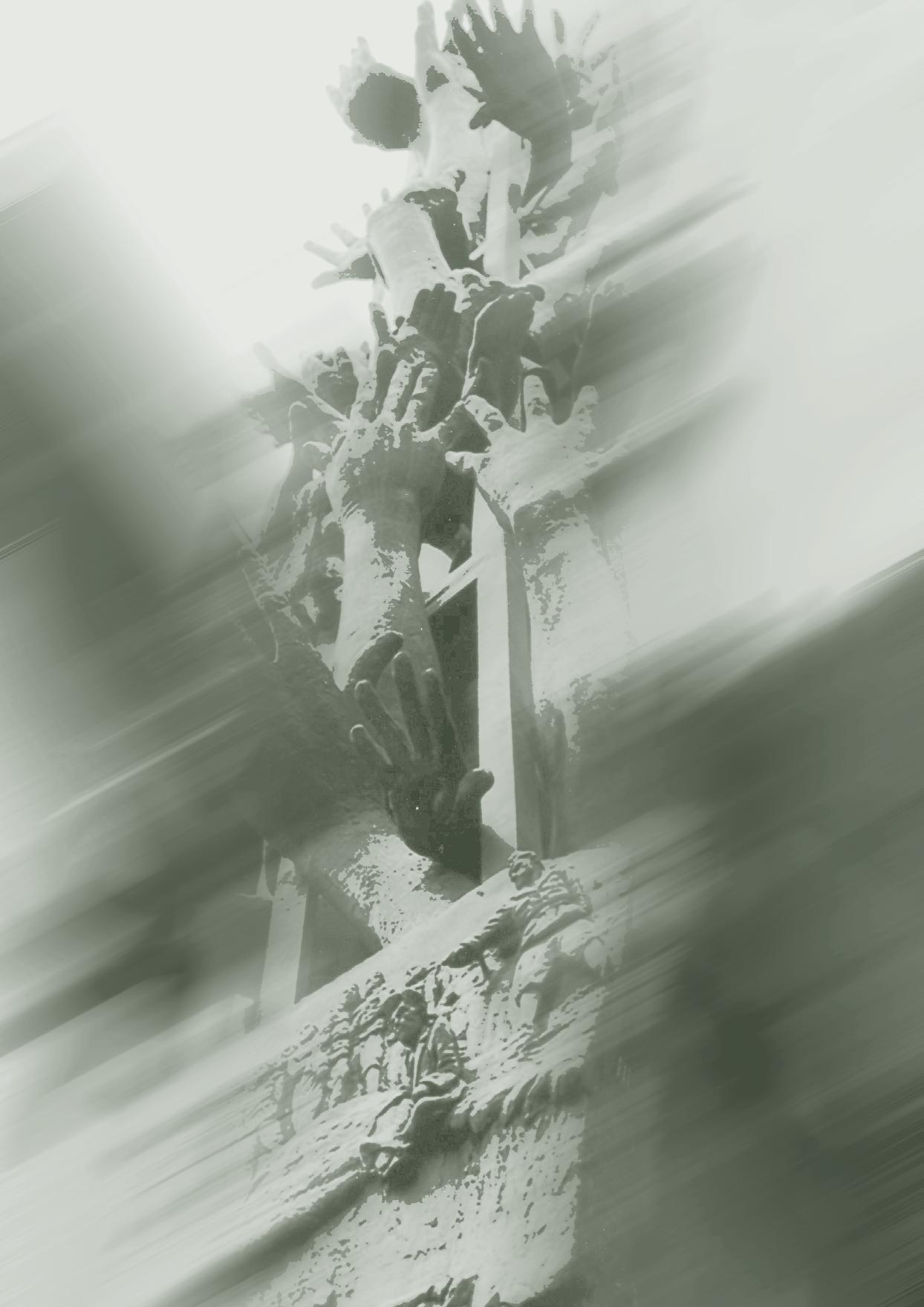
We consider the finest memorial to all victims of racist policies to be an educational programme which aims to combat anti-Semitism, racism and prejudice in the community and fosters understanding between people.
13–15 Selwyn Street, Elsternwick, Vic 3185, Australia
t: (03) 9528 1985
f: (03) 9528 3758
e: admin@jhc.org.au
w: www.jhc.org.au
OPENING HOURS
Fri:
Sun
Public Hols: 12pm–4pm Closed on Saturdays, Jewish Holy Days and some Public Holidays JHC Centre News Disclaimer: The opinions expressed in Centre News are those of the authors and do not necessarily reflect those of the magazine editor or editorial committee. While the Centre News welcomes ideas, articles, photos, poetry and letters, it reserves the right to accept or reject material. There is no automatic acceptance of submissions. CONTENTS FROM THE PRESIDENT 3 DIRECTOR’S POINT OF VIEW 4 FEATURE: KRISTALLNACHT 5 NEWS 10 MUSEUM 14 EDUCATION 16 EVENTS 19 MARCH OF THE LIVING 23 VOLUNTEERS 26 FRIENDS 28 SEEN AT THE CENTRE 30 COLLECTIONS 32 THANKS 35
Mon–Thu: 10am–4pm
10am–2pm
&
Ihave much pleasure in introducing you to our new editor, Ruth Mushin. Many will be familiar with her work as an editor working with aspiring authors in the Makor Library’s ‘Write Your Story’ programme. Welcome to the Centre family, we look forward to a long and productive association. The theme for this edition is ‘Kristallnacht, 70 years on’. Kristallnacht, an event that occurred on 9–10 November 1938 in Germany and Austria; an event that changed the nature of persecution from economic, political, and social to the physical, with beatings, incarceration and murder; the event often referred to as the beginning of the Holocaust. Many decades later, the association with the Kristallnacht anniversary was cited as the main reason against choosing 9 November, the day the Berlin Wall came down in 1989, as the new German national holiday. (3 October, the date the reunification of Germany was formally concluded, was chosen instead.)
educationalists and scholars. At the Jewish Holocaust Centre (JHC) we are examining the notion as we plan for our future. Read about the planned upgrade of our museum, our hopes and aspirations.
Earlier this year I spent a week travelling in Cataluña, in Spain, in an area not more than 120 kilometres out of Barcelona. I was amazed and intrigued to find that the Spanish are celebrating the contribution the Jews made in Spain, alongside that of the Muslims and Christians. They are reclaiming the Sephardic part of their cultural identity and it appears to be a serious business, this memorialising and owning their Jewish past. It struck me that memorialisation in its very nature is changing, and Spain is encouraging people to come and tread the landscape, just as many now do in Poland. There are parallels too with the many Australians who annually make the journey to Gallipoli.
involvement before embarking on a guided tour of the museum. I then asked if the group members could introduce themselves and what I thought would be a ten minute discussion went on for nearly one and a half hours.
In this Centre News you can read eyewitness testimonies from three of the Centre’s survivors who were there: Shmuel Rosenkranz (Vienna), George Ginzburg (Berlin) and Henri Korn (Wuppertal-Elberfeld). We also have stories about Wilhelm Krützfeld, the German policeman who courageously saved Berlin’s New Synagogue, and William Cooper, a Victorian Aboriginal man who led a deputation to the German Consulate in Melbourne to present a resolution ‘condemning the persecution of Jews and Christians in Germany’. It is also fitting that we are launching our new temporary exhibition on Nazi Medicine on the 70th anniversary of Kristallnacht
How will the Shoah be remembered? How will we memorialise? How will the rest of the world memorialise? This is a major issue confronting museums,
In April I was co-leader for the 20th March of the Living, the 5th adult group from Australia. Our group numbered 93, including participants from South Africa, USA, Canada, Israel, Venezuela and Mexico, as well as Australians from Melbourne and Sydney. It was a diverse group, with a South African journalist from Soweto as well as a radio broadcaster from Johannesburg. You can read articles by Henry Buch, child survivor, whose poignant tale deeply touched the hearts of us all, and from Eve Recht, daughter of our survivor guide, Pearl, who together with her two sons undertook the journey.
I experience a huge sense of pride when I walk through the doors of the Centre. On any day, the place is buzzing with many visitors, much movement, people going from place to place. One day it was a school group from Shepparton and I overheard one of the accompanying parents say to Zvi Civins, our Education Director, ‘I have never heard such a balanced presentation of the Holocaust, thank you.’
That day I was meeting a group of women who were visiting the Centre, consular wives I was told, so we sat together, nine women and Abe Goldberg, our survivor guide. I introduced myself, introduced Abe and talked about the JHC and my
As it turned out, the group was a German conversation group rather than consular wives, although one of the members happens to be the wife of the German consul. The level of information sharing was deep and most poignant. The group is composed of German women married to Australians and vice versa. Abe talked from a survivor’s perspective, we shared stories and talked about our backgrounds. We heard from a woman whose father was a Dunera boy, not Jewish, and all the implications for the family growing up in Australia, labelled ‘enemy alien’. We also heard about growing up in Germany, losing a sister to starvation during the war. On some level it was the children of the perpetrators and the children of the survivors and our conversation was deep and heartfelt.
It was a privilege to be part of this session and I am in awe of the role of our Centre in enabling such experiences to occur. A return visit is being planned.
We are pleased to introduce our new logo and hope you like the new look of Centre News. These are the results of much collaboration with the Centre and the creative minds of our wonderful Izi and Eti Marmur.
As a non-profit organisation, the Jewish Holocaust Centre exists through the incredible support we receive from the community. We extend our deep appreciation to all and wish to publicly acknowledge their generosity.
The Centre opened its doors in March 1984. Next year marks our 25th anniversary and there will be celebration and commemoration throughout the year. Please watch out for a series of wondrous events to mark this momentous achievement.
On behalf of myself and the Board of the JHC I take this opportunity to wish you and your families a Shanna Tova u Metuka, a happy and sweet year.
Pauline

JHC Centre News 3 FROM THE PRESIDENT
Pauline Rockman
As we approach our 25th birthday, three adjectives seem to me to describe appropriately the essence of the Jewish Holocaust Centre (JHC): resilient, vibrant and dynamic.
Bernard Korbman

The vision and aspirations of the founders and volunteers who established the JHC have stood the test of time. In twenty-five years, the period of time often used to define the span of one generation, the JHC has welcomed nearly half a million people through its doors. The survivor guides and the survivor volunteers who established the museum, archives, testimonies department and education programmes have shown more than resilience. They epitomise the triumph of the human spirit over evil and unimaginable, horrific personal experiences.
One only needs to come to the JHC on any given day to feel the vibrancy, the energy flow and the human connection that binds school children, who perhaps had never met a Jew before or had very little knowledge of the Holocaust. The atmosphere is one of informality, almost one of ‘welcome
to my home’, and certainly one of mutual respect. It is in the students’ ability to recognise the dignity of their hosts, and their hosts’ ability to treat their guests with warmth and understanding that the visit becomes a powerful educational experience.
To maintain the spirit and legacy of those who served the JHC for twenty-five years, and to establish the Centre as the major museum and Holocaust education facility for schools and community groups throughout Australia in the twenty-first century, all our departments are reviewing current practices, services, technology and programmes. This will ensure that we maintain our hard-won reputation as a ‘must visit’ Centre during the school life of a student, for many years to come. The enthusiasm and vitality, as well as the skills of the professional staff and the new volunteers, will guarantee that the Centre will be considered a relevant and dynamic place of learning and a leading voice in Australian society for social cohesion, respect and understanding.
As is our tradition, a little story must always follow to illustrate the point being made.
A few weeks ago I was admitted to hospital for some treatment and have, since my discharge, attended the hospital as an outpatient. In chatting with fifteen or so staff members under thirty-five years of age, I found that twelve had visited the JHC with their schools, including some from country Victoria. The staff ranged from
orderlies to nurses, radiotherapists and so on and they mentioned the names of survivor guides such as Thea, Ben, Adele, Maly, Zosia and Arnold with a great deal of fondness. When I advised these young people that those guides had all passed away, the reaction was one of genuine sorrow, usually with an added sentiment like, ‘I will never forget …’
Of course many of our current survivor guides were also mentioned and I was asked to pass on best wishes and a thank-you for a life changing experience. Interestingly, of the ten or so ‘over forties’ I engaged in conversation, either fellow patients or staff, only a few had visited the JHC. However, many were aware that their children or grandchildren had attended with their school. Moreover, it had been one of the few school excursions these young people had spoken about without the information having to be prised out of them – a rare occurrence with teenagers!
The JHC continues to take a proactive stand in ‘values education’ as well as history. This is illustrated by a twelve months overview of the numbers of people and organisations to whom our Holocaust education programme to combat anti-Semitism and racism was presented. In the year ending May 2008, 23,963 people visited the Centre, including school and university students, professional groups and members of the general public and a further 6,500 attended various educational outreach activities organised by the Centre.
Maly Kohn scholarship
The JHC is pleased to announce the establishment of the Maly Kohn Professional Development Scholarship.
Maly Kohn was a dedicated and integral member of the Jewish Holocaust Centre, as a survivor and guide, and through her efforts in many different aspects of the Centre. Maly was passionate about wanting guides to improve their knowledge of the Holocaust, and also to become more proficient in their educational delivery. Maly was a most competent educator and had the knack of being able to make students, young ones in particular, understand the history and the issues of the Holocaust, without ever frightening them.
Her family is proud to honour her and her commitment to Holocaust education with the establishment of this scholarship.
The scholarship is available to the Centre’s volunteer guides who have the desire to further their own knowledge of the Holocaust, either through local study, overseas travel and study, or other means.
Applications and eligibility criteria for the Maly Kohn Professional Development scholarship are available through the Centre’s Education Department.
JHC Centre News 4
DIRECTOR’S POINT OF VIEW
Remembering Kristallnacht, 70 years on
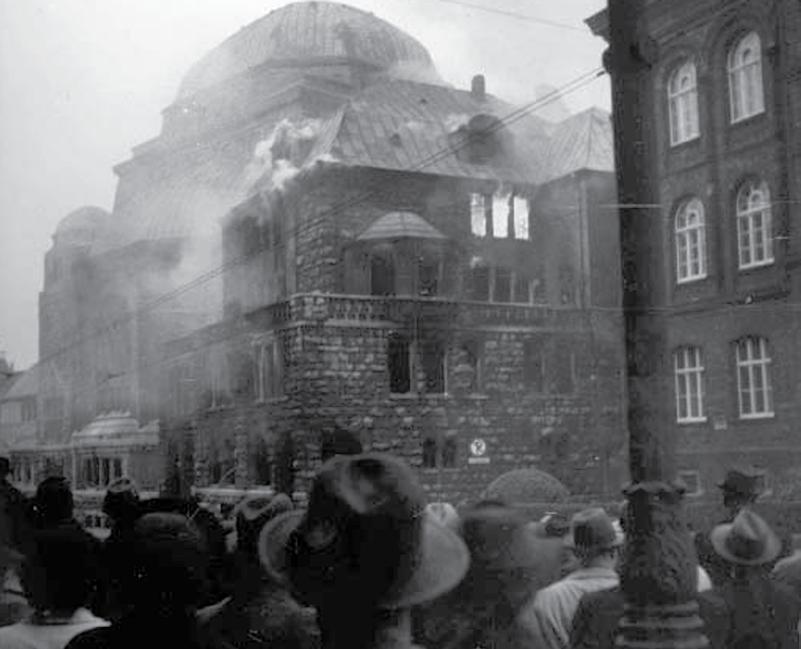
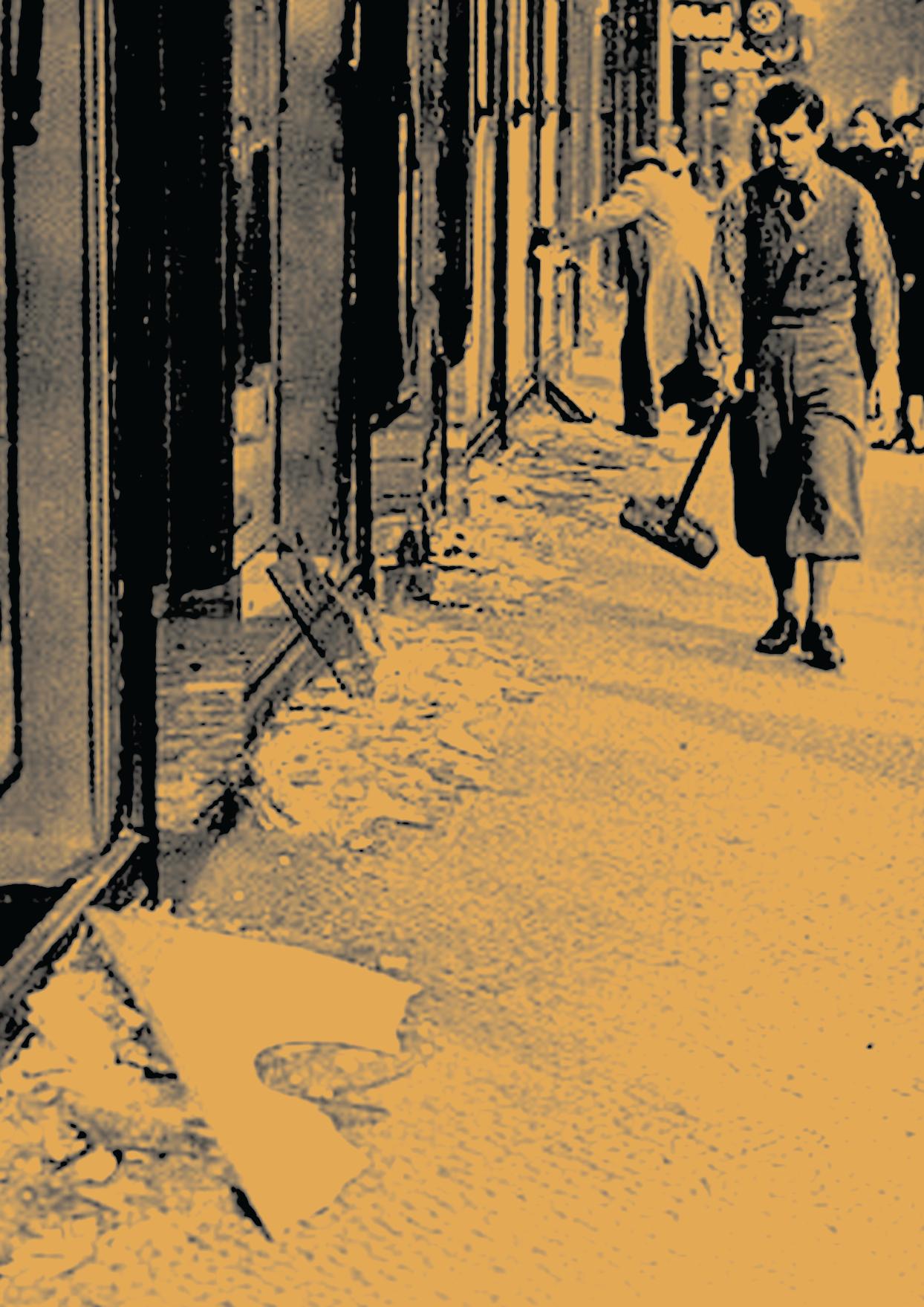
Kristallnacht owes its name to the countless shards of shattered glass which lined the streets in the wake of violent antiJewish pogroms throughout Germany and Austria on the night of 9 November 1938. Literally ‘Crystal Night’ or ‘Night of Broken Glass’, the term has become a euphemism for these brutal events, but it fails dismally to convey the suffering that was caused.
Instigated by Nazi Party officials, members of the SA (Sturmabteilungen, literally Assault Detachments, but commonly known as Storm Troopers) and Hitler Youth, these pogroms were intended as retribution for the shooting of German diplomat Ernst vom Rath by Herschel Grynszpan, a seventeen-year-old Jewish refugee in Paris. In October 1938, the German authorities had begun deporting Polish Jews back to Poland, but Poland refused to accept the deportees. Seventeen thousand Jews, including Grynszpan’s parents, were stranded in a squalid refugee camp near the border town of Zbaszyn. Herschel himself was stateless and living in Paris without a passport or visa. Enraged by the terrible plight of his family, Grynszpan shot vom Rath, who died on 9 November.
The pogroms were planned to look like a spontaneous, popular uprising against the Jews. Shop windows of Jewish businesses were smashed, stores looted, hundreds of synagogues and Jewish homes were burnt down and many Jews were attacked. Firemen and policemen were directed not to intervene unless non-Jewish property was affected. Ninety-one Jews were murdered that night and another 30,000, including many wealthy and prominent members of their communities, were arrested and deported to concentration camps at Dachau, Sachsenhausen and Buchenwald, where many died.
Following the events of Kristallnacht, the Nazis stepped up anti-Jewish measures, including seizing Jewish property, forcing the Jewish community to pay a fine of one billion Reichsmarks, ostensibly as a payback for the death of vom Rath, and setting up a Central Office for Jewish Emigration (Zenstralstelle fuer Juedische Auswanderung) to encourage Jews to leave the country. So, not only was Kristallnacht the largest scale attack against the Jews since the Nazis assumed power, but it marked the beginning of the systematic eradication of the Jewish community of Germany, a community that could trace its ancestry there back two thousand years.
Here are the stories of three people who experienced the events of that fateful night, seventy years ago.
GEORGE GINZBURG
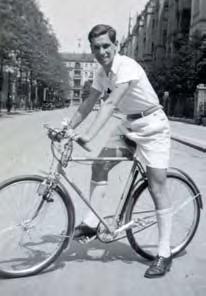
George Ginzburg was born in Danzig (now Gdansk), where his parents had settled after escaping the lawlessness in Russia in the aftermath of the Bolshevik revolution. When he was two years old, the family moved to Berlin to join his maternal grandparents. He was sixteen years old in November 1938.
Early in the morning of 9 November, shouting and strange noises woke me up and a terrible burning smell filled the air. The sky was red and buildings were on fire, not only all over Berlin but also, as I learned later, all over Germany and Austria.
I received a telephone call from my youth leader telling me to come as quickly as possible to Fasanenstrasse, the site of the burning synagogue, where flames were emerging from the roof. I ran like mad, ignoring my mother’s desperate calls as fire brigade sirens blared all around me. When I arrived at the corner, many of my friends were already assembled. Dada Kirschenbaum, our youth leader, instructed us to form a chain up the stairs of the burning synagogue, where flames were emerging from the roof. Three of our older leaders ran into the building, their mouths covered with wet cloths, as the police stood by and laughed. After a few
JHC Centre News 5
FEATURE
George on his bike in front of his house in Berlin, 1938
Passers-by watching the burning synagogue in Essen, Germany Source: Stadt Essen
minutes, though it seemed like an eternity, they came out holding the heavy Torah scrolls in their arms. They also carried blankets and curtains full of handcrafted silver ornaments from the altar. We passed all these items, some already scorched, down the chain and onto a waiting truck. A crowd of Hitler Youth was whistling at us and a fight broke out; sticks and bicycle chains were used and some of us lay bleeding on the ground. The Hitler Youth were armed with daggers bearing the inscription ‘Blood with Honour’. We were too angry to be afraid and fought ferociously until they backed off. By this time the fire was out of control and the air was filled with smoke and ash. Each of us took home some of the precious items we had saved. I returned home, exhausted, dirty and depressed.
Later that day further chaos erupted in the city. SA ‘brownshirts’ stood in front of Jewish shops holding large anti-Semitic placards and women known to have had relationships with Jewish men were paraded with humiliating signs around their necks. Shop windows were broken and goods plundered; not even the elegant department and jewellery stores on Berlin’s elegant Kurfürstendamm were spared. Violence was rampant and the mob loved it, joining in the beating, plundering and burning. The police simply stood by laughing and chatting. Occasionally people walked away in disgust, but no one dared to protest.
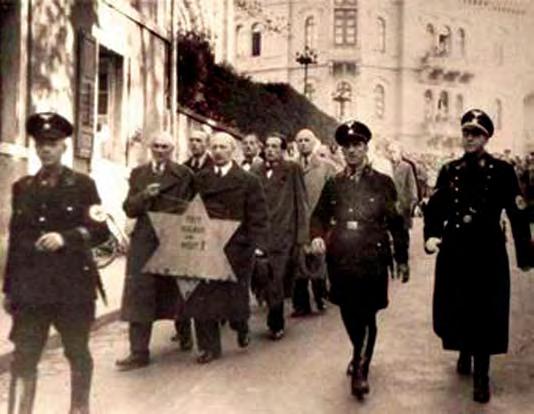
HENRI KORN
Henri Korn was born in Wuppertal-Elberfeld, Germany, in 1929. His sister, Sonja, was born two years later. Henri’s family was totally assimilated, they spoke German at home and most of their friends were non-Jewish Germans. In autumn 1938, Henri was asked to leave school as a law came into force forbidding Jewish children to attend Aryan schools. Soon the family’s non-Jewish friends began to turn their heads away when they passed them in the streets.
Noise woke me and I saw my parents anxiously looking out of the window. I joined them and saw torches flickering. Open mouths spewed words of abuse and songs calling for blood to be spilled. People, many in uniform, filled the streets.
We heard the noise of heavy boots climbing our stairs, then the harsh tones of our neighbour, Frau Lewitzki, urging the invading party to go away. Ironically my mother and Frau Lewitzki were involved in legal action, with my mother’s complaint against her due to be heard in court. However, Frau Lewitzki sprang to our defence, shouting, ‘The Korns are decent people, basically Germanic and of good character!’ As she argued, my parents, their faces grey with fear, stood at the door expecting the worst. Seeing them like that, I was terrified too. Finally, we heard
the boots descending the stairs. We had been protected by the most unlikely of saviours! Fortunately my sister stayed asleep through it all.
For the next few hours, we stood at the window watching the milling crowds. Excited youths carried large swastikaadorned flags, bellowing, ‘Let the blood flow!’ We heard distant crashing noises, but could not work out what they were.
Early next morning, my father and I went out to investigate what had happened during that terrible night. Mere words cannot describe the apocalyptic sight. The streets were littered with smashed furniture and thousands of shards of glass from broken windows. Candelabras, brassware, cutlery, bed linen, an upright piano – all had been hurled out of windows. Shops had been vandalised and stock thrown on to the footpath for anybody to pick up. Dwellings had been ransacked, women were weeping and men were wandering about aimlessly. One image that haunted me for a long time was an old grandfather clock, split in two by an axe-wielding maniac. How strange we had been spared the horror, thanks to the intervention of our nemesis, Frau Lewitzki! Later, I slipped back into the street. In the city centre, people were in a state of
Henri on his first day of school, Germany 1935
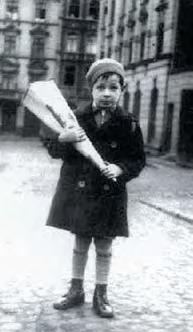
JHC Centre News 6
Arrest of Jews by the SS in Baden Baden, Germany
Source: Yad Vashem
great excitement as the synagogue was burning, so I ran towards it with all the speed I could muster. A large crowd was milling around, mostly working-class women dressed in their blue aprons whom I remember as being big and fat. Their faces were twisted with hatred and they waved their fists, screaming ‘Get rid of the Jews!’
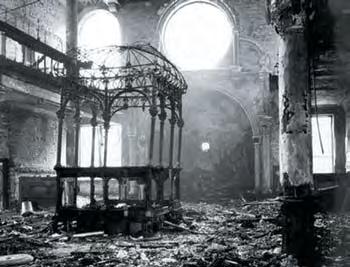
A woman was inside attempting to salvage the Torah scrolls and a torch had been thrown at her, setting her clothes alight. People laughed and applauded. I was too small to see anything, but suddenly one woman looked down at me and exclaimed, ‘This boy is a Jew, I know his face!’ Suddenly, six heads swivelled, and their eyes stared menacingly down at me. I fell on my knees and crawled amongst the many legs, managing to escape. I was shaking and hid under a bench, expecting to be pursued by an angry mob, but nobody came. I figured that the burning synagogue offered a much greater attraction. Apparently, those efforts to burn the synagogue down failed that afternoon, so the evening brought the experts, who eventually managed to destroy it. The next day, 11 November, I was drawn to see the ruins of the synagogue and noticed that the gutters of nearby streets were littered with hundreds of torn fragments of Torah scrolls. For days after these tragic events, cold and blustery north winds dispersed the Hebrew-inscribed remnants across the city.
SHMUEL ROSENKRANZ
Shmuel Rosenkranz was sixteen years old and living with his family in Vienna on the night of Kristallnacht. As soon as Hitler came to power in Germany in 1933, his mother had predicted that he would eventually occupy Austria, so she bought a property in Palestine against her husband’s wishes. However, when Hitler occupied Austria in March 1938, his father realised it was time to go, but they did not have the money required by the British to enter Palestine. Arrested by the Gestapo, he managed to escape deportation to Dachau by selling all his possessions to the Third Reich. Before Kristallnacht, the family was able to obtain landing permits for Australia and were in the process of arranging to leave Vienna.

Even though we were living in horrendous times, there are good people everywhere and my father and I survived Kristallnacht through the help of two decent men – one a Nazi and the other, a nameless stranger.
In each subdivision of each district in Vienna, a Nazi had been appointed to look after the neighbourhood and ours was called Jungwirt. Herr Jungwirt came to Mother on 9 November to tell her to make sure her husband and oldest son disappeared that night. He said there was no need for my mother or my younger brother and sister to leave.
So, that evening, Father and I went to Karlenberg, in the Vienna Woods, just outside the city. There we found a coffee lounge where we sat and drank cocoa, watching the flames of Vienna burning below us. When the café owner told us he wanted to close, Father took my hand and asked if we should take a risk and stay. To leave would be to risk attack or deportation in the woods or the city, but to stay meant that the café owner could inform on us. Fortunately, there was no need for me to decide because Father answered his own question, saying ‘What will be will be!’
We stayed in that café and not only did the owner not inform on us, but he left us in the dark with the door unlocked, so we were free to leave if we wanted.
We returned to the city in the morning to find Jewish property destroyed and the synagogues burned. Thankfully the rest of my family was safe. A few days later a law was passed requiring the Jewish community to pay for the damage caused on that terrible night. Although instigated by the Nazis, they had been in plain clothes, so that it looked like a spontaneous people’s uprising against the Jews.
Although Father had paid the German Reich to escape imprisonment, we were still able to scrape together the Reichfluchtsteuer, the tax required by the government so that you could leave the country and from then on, all our efforts were concentrated on leaving.
George Ginzburg and Henri Korn’s stories are extracts from their autobiographies: Ginzburg, George, 2007, A Will to Live, (second edition), George Ginzburg, Melbourne, and Korn, Henri, 2004, Saviours: The Story of a Jewish Altar Boy, Makor Jewish Community Library, Melbourne.
JHC Centre News 7
Shmuel, centre, with his family, Vienna
The interior of a synagogue destroyed during Kristallnacht, Nuremberg, Germany.
Source: Stadtarchiv Nuremberg
When Australia was silent:
an Aborigine fights the persecution of Jews in Nazi Germany
Hannah Miska
On 11 November 1938, The Age reported that synagogues had been set on fire throughout Nazi Germany and Austria, that shops and houses had been wrecked, streets strewn with broken glass and thousands of Jews had been arrested –the event that has gone down in history as Kristallnacht
William Cooper was miles away from Germany, living in a shabby little house in Melbourne, when he read about the burning of the synagogues.
Cooper was an indigenous Australian, or in the language of white Australia at that time, a ‘half-caste’. He was born in 1861 to an Aboriginal mother and a white Australian father, the fifth of eight children. For a short while the family lived on one of the Christian missions which aimed to ‘civilize’ the Aborigines and convert them to Christianity. The mission was ruled in a strict, paternalistic manner, but William learned to read, write and count. He also learnt about British democracy and he read the Bible. He was impressed to learn that in a democracy, as well as before God, everybody was equal.
But how much different it was in a British colony! Since their arrival, the English settlers had persecuted the indigenous inhabitants, chasing them off their lands, shooting them in bloody conflicts and herding them on to reserves. William’s family was no exception, being forced to leave the mission and move on to a reserve. Shortly after, William was taken away from his family and was forced to work as a farm labourer. Later, he worked as a coachman for a politician in Melbourne and it was there that he made efforts to educate himself. He read a lot and became well informed about local and international politics, especially countries with indigenous populations, including New Zealand, Fiji, Papua New Guinea, South Africa and the United States of America.
Cooper also watched political developments in Germany. He knew the Nazis put Jews and other minorities into concentration camps; he knew of the Nuremberg laws that distinguished between ‘Jews’ (with at least three Jewish grandparents), ‘Halfjews’ (with two Jewish grandparents) and ‘Quarterjews’ (with one Jewish grandparent), stripping them of legal rights and forbidding intermarriage.
Not surprisingly, Cooper compared the situation of German Jews and Australian Aborigines. At that time, Australian law also distinguished between full blood, half-, quarterand eighth-caste Aborigines. Permission for marriages between these categories had to be sought and was usually refused. Full blood Aborigines were regarded as incapable of adapting to modern times and doomed for extinction. They were confined to reserves on food rations, and often denied the right to work. Housing, sanitary facilities and medical care were appalling and epidemics were rife, with tuberculosis and measles claiming many lives.
Whilst full bloods were expected to die out, the remaining Aboriginal population was meant to be assimilated, so children were forcibly taken away from their parents and
families were torn apart. William Cooper remembered the shrill screams of his mother, ‘White men coming!’ warning the kids to run and hide when the police came to take the children away. Boys were sent to the Salvation Army or to farm the land and girls were sent to institutions to learn domestic skills. The children had to seek approval to visit their families, as did their families if they wanted to leave the reserves.
Cooper’s son fought in World War I and died for his country, but those Aboriginal soldiers who survived and returned to civilian life were again treated as second-class citizens – or worse, as they had no citizenship, no vote, no social security and they were not counted in the census. Many Australians thought they were primitive savages and they were denied the right to choose where to live, which school to attend or what work to do. They earned far lower wages than white Australians and continued to live in constant fear of the police, who still had the right to take away their children.
In 1936, Cooper, who was already in his seventies, founded the Australian Aborigines League (AAL), the first organised representation of Aborigines which fought for legal rights, representation in state and federal parliament and land rights. When everything failed, Cooper collected signatures for a petition to King George V. Although he had tremendous faith in British democracy, the petition was stopped by the Australian government and it never reached its destination. In January 1938, whilst white Australia celebrated the 150th anniversary of their landing in Sydney, Cooper organised a public ‘Day of Mourning’. When Cooper learned about Kristallnacht, he decided to act. On 6 December 1938, with a delegation of the AAL, he marched to the German Consulate General to lodge a protest against the persecution of the Jews. The German consul, Dr Walther Drechsler, must have felt deeply offended by a horde of ‘savages’ who dared to criticise Hitler, Göbbels and Göring, and he did not open the door. Cooper’s march remained one of the few public protests in Australia and the Australian government kept quiet. Whilst it anticipated an influx of Jewish refugees, it was not prepared to increase the quota for these immigrants. William Cooper did not achieve anything for the German Jews or the Australian Aborigines and he died in 1941, bitterly disappointed and forgotten by most Australians. The Jewish Holocaust Centre, however, did not forget. In December 2002, in a joint ceremony with the Aboriginal community, it unveiled a plaque to commemorate Cooper’s protest march against Nazi Germany.
This is a translation of an article which first appeared in the Jüdische Allegmeine, 8 November 2007.
JHC Centre News 8
Working together to heal intergenerational trauma
On 3 December 2008, the Jewish Holocaust Centre, in partnership with Indigenous community members, is holding its third annual community forum of Holocaust survivors and Aboriginal Victorians at the Centre. The aim of the forum is to celebrate William Cooper’s recognition of the universal face of racism and discrimination and the strong relationship that has grown between the two communities.
Common sense and civil courage in Berlin 1938
Hannah Miska
In Berlin, in the middle of the 19th century, the Jewish population was growing rapidly. A bigger synagogue was needed – and duly built. It turned out to be a beautiful building in a splendid eastern MoorishByzantine style with two slim octagonal towers. The façade was richly ornamented and the gilded ribs of the tower domes, together with the strikingly shimmering gold cupola, were truly an eye-catching sight. With 3000 seats, it was the biggest in Europe. Called the ‘New Synagogue’, it was inaugurated in 1866 in the presence of Chancellor Count Otto von Bismarck. More than half a century later, things had changed. On 9 November, 1938, Hitler’s stormtroops (SA), the so-called ‘brownshirts’, set the beautiful synagogue ablaze. In earlier times, policemen would act when hordes of rioters set buildings on fire, but not so during the so-called Kristallnacht Instead most of the civil servants looked away, or worse, participated in the violence and destruction of Jewish property.
Despite the horrific destruction of Kristallnacht, the New Synagogue was saved – due to the actions of one man whose name was Wilhelm Krützfeld. Krützfeld, who was then fifty-eight years old, was a Prussian police commander. He was a very correct and dutiful German, who had served in the army of the German Emperor until 1907, before becoming a policeman. Progressing through the ranks, eventually, in the 1930s, he was made commander of Police Station 16 at the Hackescher Markt. His patch included Oranienburg Street, the very street where the synagogue stood.
Koora Cooper, the great grand niece of William Cooper, has been working with RMIT University to help organise the forums. But for Koora, an activist and community worker of many years, the forum is much more than an academic exercise.
Says Koora, ‘We have a strong partnership starting from when Uncle William Cooper stood up. It’s been 70 years of working together and we have built agencies from Jewish and Koori people coming together. A Jewish lawyer and Uncle Jim started the Koori Heritage Trust … and without Jewish community support I don’t think the Koori Heritage Trust, or for that matter the Aboriginal legal service, would be around today.’

A key theme of the 2008 forum will be the issue of intergenerational trauma, with presentations from indigenous and Jewish speakers. The forum will look at the impacts of intergenerational trauma and dispossession, of being made non-citizens in one’s own land, and the implications for Kooris of possible future compensation for members of the Stolen Generation.
The discussions, which will be held in a spirit of collaboration and partnership, are sure to be passionate and emotional.
If you would like to attend please contact Lena Fiszman on 9528 1985 or email LenaF@jhc.org.au.
When Krützfeld heard of the fire, he took a few of his policemen, walked to the synagogue and ordered the Nazi mob to disperse. With a drawn pistol, he produced a paper to show that the synagogue was a registered architectural monument protected by law, and declared that he was going to uphold that law. The brownshirts obeyed, the fire brigade was ordered to extinguish the fire, and the synagogue was saved from destruction.
This action to quell the SA terror was, at the time, an extraordinary deed. Krützfeld was lucky to get away with light disciplinary action – the next day he received no more than a verbal warning from the President of the police. A year later, he was moved to a different police station, and, in 1943, he resigned for ‘health reasons’ and went into early retirement.

When he died in 1953, Krützfeld was a forgotten man. But in 1992, the city of Berlin awarded him an honorary grave at Georgen-Parochial Cemetery. The New Synagogue, which he had saved during the Kristallnacht, was badly bombed in 1943, but was reconstructed after the Berlin Wall came down and was re-opened in 1995. A plaque to commemorate the spirited action of Wilhelm Krützfeld stands by its side.
Schleswig-Holstein, the state of Germany where Krützfeld was born, honoured the policeman on 9 November 1993 by renaming the State Police School the Wilhelm Krützfeld Police School. In a memorial page, it says of him:
He was neither a victim of the Nazi regime nor a resistance fighter, neither social democrat nor communist, neither a classic hero nor a martyr. He was just a man with common sense and civil courage.
Further reading: Heinz Knobloch, The bold head area: Unusual courage at Hackeschen Markt, Jaron, November 2003.
9 JHC Centre News
William Cooper
Wilhelm Krützfeld
On Queen’s Birthday 2008, Phillip Maisel was awarded a Medal of the Order of Australia
Phillip Maisel OAM is a true reflection of the word ‘gentleman’. He epitomises hard work, dedication, a love of fellow man and the virtues of compassion and humility.
Everyone is well aware of Phillip’s tremendous creative vision and output, including his taking of testimonies before the Shoah Visual History Foundation began filming survivor testimony. What is less well known, however, are the countless numbers of tertiary students to whom Phillip has been a mentor and the many films he has produced for hundreds of organisations who have wanted to either teach or commemorate the Holocaust. Also, very few people are aware that Phillip has, over many years, been one of our major financial benefactors. His latest financial contribution, in memory of his beloved late wife Miriam, is to sponsor the research and writing of the history of the Jewish Holocaust Centre by five academics from Deakin University. All of us at the Holocaust Centre have been truly blessed to have the opportunity to call Phillip Maisel a friend and colleague.
Tribute to Phillip Maisel
Between a medal of honour and a salad sandwich
Adam Brown
For the past six months, I have had the indescribable privilege to work with Phillip Maisel in the testimonies department of the Jewish Holocaust Centre in Melbourne. Following a simple request for a resource for my studies, Phillip took an immediate and immensely gratifying interest in my work. A survivor of the Vilna Ghetto and several Nazi concentration camps, Phillip opened up without hesitation to share with me his life experiences, and a friendship blossomed to become as strong as it was instantaneous.
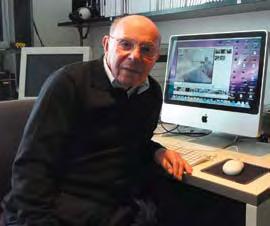

On a professional level, Phillip has been the primary force in collecting and preserving survivor accounts for posterity, working indefatigably over a period of sixteen years to collect more than 1,300 video testimonies. Now eighty-five, Phillip has been made the recipient of the Order of Australia medal for community service to honour his tireless efforts. Even with years of devoted thought I could never conjure up a more deserving person.
On a personal level, Phillip’s calming presence and generosity are blessings to me and to all those around him. He possesses a sense of dignity that I have honestly not encountered elsewhere, and his good humour and quiet modesty have helped me persevere with my own work. The pleasure that Phillip takes in a simple sandwich – always ‘the usual’ when we have lunch together – moves me in the way such a small gesture can stand for what is truly human.
Writing so glowingly of someone might be said to entail the risk of offering excessive praise, and Phillip himself would probably make such a criticism. Yet it is when writing about such a man that the true paucity of words becomes clear. My time as a student will soon be over. However, I am certain that the truly humbling friendship I share with Phillip will continue for many years to come… at least until he finally lets me pay for lunch!
JHC Centre News 10
NEWS
Farewell to Thomas Kessler

Bernard Korbman
It was with a feeling of regret and sadness that the Jewish Holocaust Centre hosted a farewell brunch for the Consul General of the Federal Republic of Germany, Mr Thomas Kessler, and his wife Mrs Elke Kessler.
We first met Thomas and Elke when they accompanied the German Ambassador to the Holocaust Centre in 2004. I had organised for the late Arnold Erlanger to host the German Ambassador and his party and Thomas and Elke immediately developed a close friendship with Arnold, exchanging personal invitations to one another’s homes.
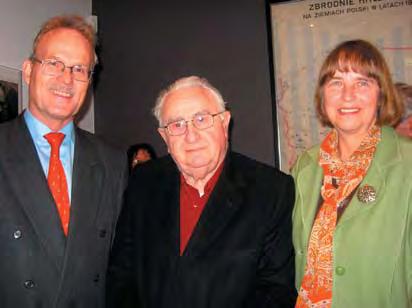
Thomas and Elke both visited the Holocaust Centre on a number of occasions and were passionate and strongly committed to Holocaust education. They never refused invitations to participate in Centre-related events, seminars and lectures. For me, the highlight of one of Thomas’s presentations at the Centre was his address to a Young Friends of the Holocaust Centre’s commemoration for Yom Hashoah in 2006. There were over 150 young Jewish people in attendance and Thomas, Elke and their son, Ulrich, were the special guests for this occasion. The
feeling of warmth, friendship and trust permeating the hall through Thomas’s honest and compassionate speech, plus Elke and Ulrich’s participation, is one of those uplifting moments I will always cherish.
Although Thomas has officially retired, his commitment to enhance Holocaust education, especially in Germany itself, has lead us to work on a joint project which we will put to the relevant German and Australian authorities when we complete our written proposal.
All the survivors, volunteers, staff and the Board wish Thomas and Elke well in their retirement and sincerely thank them for their ongoing support.
Beryl Chitiz Retires
Tradesmen, sign writers, cleaners, insurance brokers, you name it, Beryl organized it, and always at the best price!
Beryl has been part of the JHC for twenty-one years and is its longest serving employee. Her job interview was in Yiddish, which was the language of the Centre at that time (and even used for the minutes of meetings).
For the first sixteen years, Beryl was the sole employee at the Centre and often she was the first point of call. There wasn’t any aspect of it she was not involved with – from booking the schools programmes, taking the minutes of Board meetings, organizing the donors’ programmes before the days of computers, shopping for supplies and presents and anything else that needed to be done.
Beryl quickly became much more than an employee and her family became part of the JHC family. Although she lives in Doncaster, she and her husband, Trevor, often came all the way to Elsternwick in response to a security or fire alert. And, when things had to be done during school holidays or on Sundays, Beryl would
schlep her children, Leigh and Gaby, along with her. We thank all the Chitiz family for their twenty-one years of support and friendship and, in particular, Trevor for his immeasurable help as computer expert, caterer, cleaner, handyman and taxi driver. Your presence will be sorely missed.
As part of the ‘founders brains trust’, Beryl helped articulate the Centre’s vision and put it into practice and her knowledge is irreplaceable. On a more personal level, Beryl has always been a loyal, reliable, trustworthy and supportive work colleague.
Beryl, the Board, volunteers and staff all wish you all the best in your retirement and hope that you take great pride and satisfaction in knowing that your name and deeds are forever inscribed in the history of the Centre.
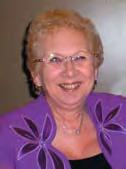
JHC Centre News 11
Beryl Chitiz
Thomas Kessler, Shmuel Rosenkranz and Elke Kessler
Thomas Kessler receives the Holocaust Centre Certificate of Appreciation
Vale Irena Sendler, Righteous Among the Nations

Witold Krzesiński
of them survived the war. Irena Sendler recorded their true names and preserved them in buried jars. Arrested, tortured and sentenced to death by the Gestapo, she did not betray her helpers and children, and she escaped thanks to the assistance of her organisation. After the war she tried to find the children and return them to their living parents. She narrowly avoided the next death sentence from the communists because of her work for the ‘reactionary’ exiled government. Ironically it was not her compatriots but four students from the United States who presented her life achievements to the outside world.
Irena Sendler never wanted to be seen as a hero. In 2005 she reflected: ‘We who were rescuing children are not some kind of heroes. That term irritates me greatly. The opposite is true – I continue to have qualms of conscience that I did so little. I could have done more. This regret will follow me to my death.’
She always underlined that she could not have done much without helpers who took personal risks day after day to prevent the destruction of human lives: ‘I am the only person still alive of that rescuing group but I want everyone to know that, while I was coordinating our efforts, we were about twenty to twenty-five people. I did not do it alone.’ She also said that her decision to save people from the Holocaust was self-evident: ‘I was taught that if you see a person drowning, you must jump into the water to save them, whether you can swim or not.’
There is a beautiful maxim in the Talmud: ‘Whoever destroys a soul, it is considered as if he destroyed an entire world. And whoever saves a life, it is considered as if he saved an entire world.’ These wise words are related to the honourable title ‘Righteous Among the Nations’. No wonder that I admired so much my compatriot Irena Sendler, one of more than 6,000 Polish bearers of this title and an honorary citizen of Israel, who died in May 2008 at the age of ninety-eight.
Irena Sendler rescued between 2,500 and 3,000 Jews in a country occupied by the Nazi Germans, who imposed the death penalty for any help given to Jewish people. She started to save her Jewish compatriots shortly after the invasion of Poland in 1939. After the Warsaw Ghetto had been established by the Nazis, she joined Żegota (Council for Aid to Jews), an underground resistance organisation which was led and financed by the Polish government-inexile in London.
She recruited volunteers and organised the smuggling of children from the ghetto. They were placed in Catholic convents, orphanages and hospitals and given new gentile identities. Many were adopted by Polish families and most
Irena Sendler is sometimes called the ‘Schindler that nobody knew’. In fact, the recognition of her heroism came late. And even though she did save three times more human beings than Oskar Schindler, there are no novels or feature films about her life. She did not get the Nobel Peace Prize although she was nominated. Nonetheless she should not be compared to Schindler or to anybody else who saved people, Jew or gentile, Polish or Russian, German or French. Irena Sendler, Oskar Schindler and also tens of thousands of anonymous heroes who saved even one life show us the better, the noble face of the human race and allow us to believe that good can prevail over evil. We should be ready to follow their examples, but also to do our best to prevent situations arising in which we would be forced to ‘save an entire world’.
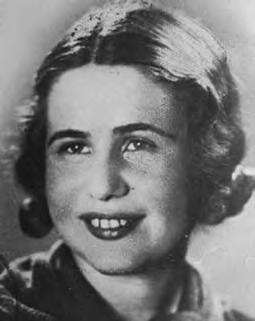
JHC Centre News 12
Witold Krzesiński is Chargé d’Affaires, Embassy of the Republic of Poland, Melbourne
Irena Sendler in Warsaw c 1939
Source: USHMM, courtesy of Yad Vashem Photo Archives
Irena Sendler Source: e-mago.co.il
Irena Sendler: a true heroine Sue
Hampel
‘A hero is someone doing extraordinary things. What I did was not extraordinary, it was a normal thing to do.’
Sometimes in life, you get to meet the most incredible people, real live heroes who inspire you with their stories. Irena Sendler was one of these people.
I had the privilege of meeting Irena Sendler in April 2007, when I was in Poland on the March of the Living (MOTL). The meeting had been arranged well in advance by Frances Prince, Education Officer MOTL Australia, and the Polish Consul General, Ryszard Sarkowicz. Ellie Braitberg from Melbourne and Sami-Jo Adelman from Sydney accompanied me to this extraordinary meeting in a nursing home in a tree-lined street in suburban Warsaw.
I had read so much about Irena and was looking forward to finally meeting her. I certainly wasn’t disappointed. At ninety-seven years young, Irena had a sparkle in her eye and she was still sharp, intelligent and eager to discuss the role she played in saving the lives of 2,500 Jewish children incarcerated in the Warsaw ghetto. Irena sat regally in her armchair, surrounded by hundreds of letters, photos and presents from well-wishers around the world. She was most excited to receive our koalas and kangaroos and we discovered that there is no word in Polish for these Australian icons!
Irena’s family employed a Polish university student to meet, greet and translate for the stream of visitors who came daily to chat to Irena. She was happy to speak about the past and as she reminisced, her eyes became moist. Her story began with her father, a respected doctor in Otwock. From an early age, Irena was taught that it was important to help others less fortunate, no matter what religion or background. It was a principle that she adhered to her entire life.
When the war broke out in September 1939, Irena had been working as a social worker. When the Warsaw Ghetto was sealed in 1940, it became her mission to save as many Jewish children as possible. Ostensibly visiting the ghetto to report on a typhoid epidemic, in reality she began to smuggle babies out. Trying to convince young mothers to give up their babies, Irena said, ‘It was terrible, heartbreaking, but it was their only chance for survival.’
Irena sedated the babies, who were as young as three months of age, and tenderly placed them in a wooden box strapped to the front of her bicycle. Irena used to take a German shepherd into the ghetto and if a child began to stir, she would step on the dog’s paw so that its bark drowned out the baby’s cries. The information she recorded about the children and hid in glass jars under an apple tree in her neighbour’s garden ensured they could be traced later.
Irena told us about her capture by the Gestapo and imprisonment in the notorious Pawiak Prison. Her legs were broken under torture, but Irena refused to divulge any information, preferring to die than expose her rescue networks to the Nazis. Irena was sentenced to death by firing squad, but her underground contacts managed to
bribe someone in Gestapo headquarters and she escaped. She then went into hiding and changed her name and her appearance, but she continued helping Jews. Irena explained that the saddest day of her life was when her mother died and she was unable to attend her funeral for fear of discovery.
Asked about why she risked her life to help Jewish children, her answer was simple and clear: ‘For the world to be a better place, love and tolerance are necessary. My heart told me to do what I could to help.’
Irena’s story remained largely unknown for many years, even to her family. In 1965, Irena was recognised as Righteous Among the Nations and her name is inscribed on a plaque next to one of the five trees at the entrance to Yad Vashem in Jerusalem.
In 1999, four schoolgirls in Kansas were researching information for a project about heroism during the Holocaust. They ‘discovered’ Irena and decided to write to her. To their surprise, this real life heroine was still alive and they visited her in Warsaw. Since then, her story of bravery, courage and compassion has become known around the world. In Poland today, there are more than one hundred schools named after this selfless lady.
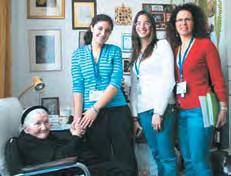
Sue Hampel is Director, MOTL Australia and Holocaust Studies Teacher, Mount Scopus Memorial College and Tutor in Holocaust and Genocide Studies at Monash University.
Irena Sendler Commemoration INVITATION
Please join us for a special evening to commemorate and celebrate the extraordinary righteousness of the late Irena Sendler, to be held on Monday 17 November at 7.30pm
Venue: Kadimah Hall, 7 Selwyn St. Elsternwick
For information and bookings (essential), please contact the Jewish Holocaust Centre on 9528-1985 or email: LenaF@jhc.org.au
The event is being partnered by the Jewish Holocaust Centre, The Polish Community Council of Victoria and The Consulate for the Republic of Poland


JHC Centre News 13
Irena Sendler, Ellie Braitberg, Sami-Jo Adelman and Sue Hampel
Centre’s curator attends Conference in Jerusalem
I was extremely fortunate to attend the 2008 Yad Vashem Holocaust Education Conference in Jerusalem along with 700 educators from 52 countries. I met people from Estonia, Colorado, Germany, Brazil, Czechoslovakia… and that was just at the breakfast table!
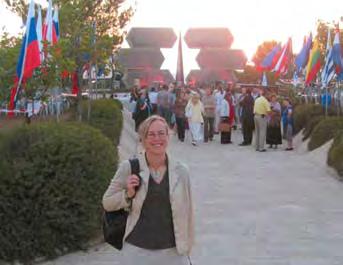
It is inspiring that so many educators, mostly non-Jewish, from so many nations are working in the field of Holocaust education. The many and varied ways these teachers have found to communicate and connect with their students is also admirable and the fact that 700 educators had the opportunity to interact, discuss ideas, debate and network was tremendous.

During the conference I spent many hours exploring the truly remarkable museum display at Yad Vashem. The highlight of my trip was meeting the museum curator, Yehudit Imbar, and I also met with key employees working in the archives. These discussions were fruitful and will prove vital in years to come as we remodel our museum and make improvements to our collection processes. I even trekked to the north of Israel, to the Western Galilee between Akko and Nahariya, where I had a tour of the wonderful Ghetto Fighters’ House Museum – which combines old fashioned museum and modern displays.
Avner Shalev, Chairman of Yad Vashem and recent visitor to our museum, sent us all home with a clear message: tell your students not just of the facts of the Holocaust but fill them with stories of human beings – before, during and after the Holocaust.
JHC thanks Yad Vashem and the Australian Friends of Yad Vashem for sponsoring this trip.
Museum upgrade –well on its way
The Jewish Holocaust Centre will remodel its permanent museum display as part of its 25th anniversary celebrations next year.
In recognition of the legacy of the survivors who founded and nurtured this unique centre, our primary aim is to bring their remarkable stories into the museum display, alongside the artefacts and documents they have donated to our Collection. We want to modernise the display, incorporating new technology with traditional exhibits. We want school students and other visitors to be captivated by the experience, to find points of connection to the stories we tell and to leave both emotionally engaged and more aware of the history of the Holocaust and its relevance to today’s world.
The content for the new museum is being developed by the Curator, Jayne Josem, who is working closely with the Education Director, Zvi Civins, ably assisted by a team of staff and volunteers.
Museums are not textbooks and they are not two dimensional, and in order for them to be successful they need
artefacts. These items can have real impact where words alone cannot. We have some interesting items in our collection – camp uniforms and a few other precious mementos – but the reality is that few people came out of the Holocaust with tangible evidence of their horror. And if they did have anything, many disposed of these reminders long ago. Today we appeal to the community with a simple request: the more objects we can display in our museum, the more opportunities we have to arouse the interest of our visitors.
If you have any precious mementos from this period you would be willing to part with, please contact Jayne Josem at the Centre. Although we are well aware of the difficulty of parting with rare family treasures, we invite you to think of it not as giving something away but rather sharing it with a much wider audience. Ideally we want to have a range of artefacts to rotate through the display because, for preservation reasons, we cannot put precious objects on permanent display. The more items we have, the more ability we have to rotate sensitive items. We look forward to hearing from you!
14 JHC Centre News MUSEUM
Jayne Josem
Jayne Josem at Yad Vashem
Holocaust survivor and artist, Samuel Bak, at the Conference
Nazi Medicine Exhibition 9 November 2008 – 31 January 2009
Research Fellow, School of History and Philosophy, University of New South Wales, Adjunct Lecturer, School of Humanities, University of New England
The Jewish Holocaust Centre will host a special temporary exhibition on Nazi Medicine from November 2008 until the end of January 2009. The exhibition will be launched on the 70th anniversary of Kristallnacht, 9 November 2008.
The exhibition was created by Sydney orthopaedic surgeon, Dr George Weisz, who passionately and tirelessly researched and developed it over many years. He worked with the Sydney Jewish Museum and was assisted by notable historian, Professor Konrad Kweit. The exhibition has been a great success in Sydney, where it appeared at the Jewish Museum.
From the time Dr Weisz first contacted our Centre we have been keen to host this exhibition, for it is such an important subject and one that we have not had the opportunity to explore in depth. The display covers the key areas where Nazi doctors practiced their brand of deadly medicine:
eugenics, euthanasia, extermination and experimentation. Central to its focus is the concept of medical ethics. Eugenics was a form of selective breeding that the Nazi regime keenly embraced and promoted, particularly to exclude those groups they deemed undesirable, such as Jews, people with disabilities, Sinti and Roma (‘gypsy’) and others. In 1939, Professor Eugen Fischer, the Director of the Kaiser Wilhelm Institute for Anthropology in Berlin, stated: ‘I do not characterize every Jew as inferior, as Negroes certainly are…but I reject Jewry with every means in my power, and without reserve, in order to preserve the hereditary endowment of my people.’
The exhibition addresses euthanasia during World War II and includes the statistic that approximately 200,000 people were murdered with the help of doctors through starvation, exposure, narcotic ingestion, lethal injections and carbon monoxide gassing. In order to improve humankind the Nazis advocated forced sterilization, medical experimentation and, eventually, extermination of groups they deemed undesirable.
For the medical experimentation display Dr Weisz interviewed Jewish Holocaust Centre guide Stephanie Heller who was, with her twin sister, the subject of medical experimentation under the direction of Dr Joseph Mengele. The forced experimentation on humans during the war is one of the many examples of inhumane and unethical behaviour by Nazi doctors during the war period. With its accompanying public programme, we believe this exhibition will offer a challenging and stimulating educational experience.
Public Forum: The Role of Health
Professionals as Agents of State Control
Professor Leon Piterman
To coincide with the Holocaust Centre’s exhibition on Nazi medicine, the Centre will hold a forum on Nazi Medicine: The role of health professionals as agents of State control in November 2008.
The atrocities committed by Nazi doctors and health workers against Jews, gypsies, homosexuals and political prisoners are a well-known and well-documented part of Holocaust history. Although Dr Mengele was one of the most infamous perpetrators, he was not alone. Experimentation and torture were systematically carried out, leaving indelible scars and irreparable damage to body, mind and soul. This was in contravention of medical ethics, including agreements to which the Germans themselves were signatories. We still have survivors who can relate their own horrific testimonies.
However, the Nazis were not alone in enlisting or coercing health professionals to engage in acts of torture to meet
the goals of the State. State-sponsored torture with medical assistance has continued and still occurs today. There are well-documented cases of psychiatrists in the former Soviet Union certifying political prisoners insane and then engaging in unethical treatment practices, including inappropriate electrical shock therapy and the use of drugs in order to extract information. There was complicity at worst, or abrogation of duty at best, by doctors in the documented torture and death of Steve Biko and others during the Apartheid regime in South Africa.
We are less clear about the role of doctors and health professionals in the Pol Pot killings in Cambodia, but we do know about the role of health professionals in torture in Chile and various African conflicts. And who knows what is taking place in Guantanamo Bay? Neglect or failure to whistle blow may also have occurred closer to home in our own infamous migrant detention centres. Whilst this may not be equivalent to torture, medical professionals
JHC Centre News 15
‘Nazi medicine remains the darkest page in the history of medicine’
Dr George Weisz
turning a blind eye may have the same outcomes.
Doctors are not immune from perpetrating mass murder or serial killings, either directly, as in the case of the infamous Dr Harold Shipman, the British general practitioner who may have killed over two hundred and fifty patients, or indirectly, as with the recently captured Dr Radovan Karadzic. Dr Karadzic, the former Bosnian Serb leader and a psychiatrist by training, oversaw the ethnic cleansing of over eight thousand Muslim men and boys. Still at large is the second in charge of Al Qaeda, Dr Al-Zawahri, a paediatrician and the founder of Egyptian Islamic Jihad, who has been indicted for the 1998 bombings of US embassies in Dar Es Salam, Tanzania and Nairobi, Kenya.
So what makes individuals who take a Hippocratic oath, who have been trained to save lives and respect the sanctity of life, turn to violence, mass murder or acts of torture and unethical experimentation? Is this part of the dichotomy of good and evil in human beings generally? Are there any circumstances at all where a medical practitioner can justify complicity with torture? What if torture extracted vital information that might save thousands of lives? What if a suspected terrorist planning the Twin Towers bombing were captured and the administration of drugs or electrical stimuli extracted details of the plot? In cases like this, should medical personnel assist?
This forum will explore both the causes and the effects of health professionals’ participation in State-sponsored crimes. Everyone is welcome, but people working or studying in health, legal or social welfare fields are strongly encouraged to attend. The expert panel will include Paul Komesaroff (Ethics), Dr Ida Kaplan (Psychology), Prof Harry Minas (Psychiatry), Prof Chris Goddard (Social Work) and Prof Ian Freckelton (Law).
Date: Sunday 23 November 2008
Time: 1.30–5.00pm
Venue: Smorgon Auditorium, Jewish Holocaust Centre
Cost: $25 adult/professional
$15 student/concession
Bookings are essential.
Enquiries Lena Fiszman
t: 9528 1985
e: LenaF@jhc.org.au
Letters from Students and Teachers
From Suzi Williamson, Student, Belmont High School, 8 March 2008
I think it‘s great that these survivors and their families now are pouring their time and effort into this museum so that we can learn about and understand the Holocaust, so that it‘s not just a forgotten part of history.
From Kyra and Danielle, Students, Macleod College, 20 March 2008
The perspective we gained on this horrible time in history is invaluable and we learnt so much more than textbooks could ever teach us – the human side we witnessed will stay with us forever.
It was an emotional experience, with our wonderful guides opening their wounds yet again to share with us the ordeals, struggles and horrific times they went through.
Most of all, our visit stressed the importance of tolerance and the dangers of discrimination, and what can occur when humans turn on one another. Hopefully with this perspective and understanding, the mistakes of the past will not be repeated.
From Seymour Technical High School, 22 May 2008
The experience we had, being able to see real documents, photographs and families of survivors was extremely moving and made the events so real.
Your museum is a great reminder of the strength of humanity through terrible times and to never give up hope. It was an experience we will never forget and many of us hope to return.
From Patterson River Secondary College, May 2008
It was a learning experience that us students won’t ever forget. We found it very moving listening to a survivor who had actually been there and had actually been through the disturbing things we had learnt. It was such a strong message that you told us, about not sitting back when something horrible is being done.
From Luana Hmilij, Student, Catholic Ladies’ College Ltd, Eltham, 23 June 2008
I am very privileged to have heard their stories, because they had literally experienced what I have been learning about at school. I thank them for sharing their experiences with me and my peers because it expanded my understanding of that devastating and unjust event.
From Peter Cattapan, VCE History Teacher, Reservoir District Secondary College, 11 February 2008
I felt the Centre had a real message of tolerance for [our students] and I felt the format of bringing the students for a final reflection really rounded off the experience.
From Liz Rush, English Teacher, Belmont High School, 7 April 2008
I have never seen such a large group of students listen so intently, and communicate with such sensitivity and compassion.
… I was impressed by the strength of the message about the uselessness of hatred, and how students were so taken by the idea that the Jews had been able to accept the atrocities of the Holocaust and to then turn their emotions into a positive message for the rest of the world.
JHC Centre News 16
Professor Piterman, Monash University is the convenor of the seminar.
What’s new in the education programme?
 Zvi Civins
Zvi Civins
It is clear to even the most casual observer that the world teenagers live in is vastly different from even ten years ago. The internet, laptop computers, ipods and mobile phones are commonplace, almost ‘essential’ items that many teenagers not only own, but know how to use in a variety of ways. Students can tour the Lodz ghetto on-line. They can hear survivors’ testimonies and download them to their ipods. They can see, courtesy of Google Earth, exactly where a concentration camp was, and be linked directly to further information courtesy of the United States Holocaust Memorial Museum.
Their ability to find almost unlimited amounts of information with the press of a button does not, however, mean that they understand these facts, or recognise the meaning of the events which they can so easily access. Learning is more than acquiring information. Learning requires opportunities to think, to ask questions and to understand the broader context of the many facts and figures to which students are exposed. Our students require direction, guidance and the opportunity to think deeply about these images and facts, and teachers often tell us they need support as well.
To answer the teachers’ concerns and needs, we have written new material comprising eighteen questions and answers about the Holocaust as background
information. This is emailed to all schools before they arrive and teachers are welcome to use it as they see fit.
One change all these technological developments made is evident during a survivor’s testimony. The testimony is still the jewel in the crown of the educational programme, but now almost every survivor who speaks to a school group has a personal PowerPoint slide show with images and maps which help provide a context to the testimony. Students, after all, are so used to having material accompanied by visual images and learning aids. We cannot take for granted that all students know where Poland is, much less where or what Lodz is, for example. Now, our survivors’ family photos, images of their homes, their camps and their post-Holocaust lives help create a more rounded and memorable experience for our students. The images also help to bring their words to life.
There is also a more detailed and interactive introduction to the Holocaust, also utilising a PowerPoint slide show, where students are asked to define key words such as genocide and Holocaust; to understand the development of the Holocaust, and to ask as many questions as possible. In doing so, students are not just passive recipients of facts, but are encouraged to think more deeply and understand the complexities and depth of this challenging topic.
Students tour the museum in small groups and each group is accompanied by a guide. The guides have been developing skills and techniques for asking students to observe specific photos or documents, to enable them to identify the significant aspect of the Holocaust which the particular image conveys. Rather than telling students what they are looking at, we ask them to look closely at a
picture and tell us what they think is happening, or why this is such an important photo, or what happened just before or after the photo was taken. By providing the students the opportunity to engage with the images, they become active learners, finding greater meaning in what they have seen.
Another significant addition to the school educational programme is the Reflections session at the end of the visit. We ask students to reflect on all they have seen and heard, and what they are thinking and feeling. After silent reflection, they discuss their thoughts with each other and then share their reflections with the whole group. This gives the guides, and the teachers, the opportunity to hear from the students just what they are thinking and feeling. It also provides a perfect opportunity to help summarise what the Holocaust means to them, to our community, and to the community at large.
We also ask the students to compose a mission statement for the Centre and then compare their attempts to the actual mission statement. I am so pleased that the students invariably suggest a mission statement that is almost word for word our actual one. They all understand that the Holocaust is a tragic model of the evil and danger of racism, and that it teaches the world how important it is to not be a bystander in the face of prejudice, intolerance or racism. Finally, at the very end of the school visit, we ask a few students to light a candle of remembrance and, accompanied by the survivor who has spoken to them, to place it in our remembrance room. This simple ritual is a powerful way of summarising and reinforcing all they have learned in their short time with us.
Yes, it is clear to even the most casual observer that the world teenagers live in is vastly different from even ten years ago. The Jewish Holocaust Centre has met the challenges these changes present, and will continue to do so in our shared efforts to educate hundreds and thousands of students.
JHC Centre News 17 EDUCATION
Caring for older survivors of genocide and mass trauma
Karen Teshuva
Looking after older survivors of genocide and mass trauma poses enormous challenges for Australia’s aged care sector in the years ahead. The Lincoln Centre for Research on Ageing at the Australian Institute for Primary Care, La Trobe University, Melbourne, in collaboration with Jewish Care Inc and the Aged Care Branch of the Victorian Department of Human Services, is conducting a study into this issue. The study initially focuses on survivors of the Jewish Holocaust and Cambodian Genocide – two groups now well-represented in aged care statistics.
With government figures showing that 70% of people entering Australia under humanitarian programmes in the last two decades have experienced torture and trauma, this will be an area of ongoing concern for aged care.
Project investigators are gathering qualitative information from aged care managers and direct care staff to document their experiences of working with older survivors. A survey of community and residential aged care managers has been conducted to document existing staff training and support for working with this client group. Older survivors and their families (including Holocaust and Cambodian survivors and
elders from more recently arrived refugee communities) will be interviewed to learn about their experience of home and community care and residential aged care facilities.
Preliminary research findings suggest it is important that aged care workers have an understanding of issues such as the historical events and the uniqueness of each survivor’s experience; the onset of dementia, which can trigger traumatic memories from the past; and diversity in the ways that genocidal trauma impacts on older people’s lives. Very little empirical research on this topic has been reported in the academic and professional literature. This study will help inform future training and support for aged care workers and assist the aged care sector to become more responsive to the needs of Holocaust survivors and older people from other refugee-like backgrounds and their families.
For more information about this study please contact Karen Teshuva, Project Manager, Lincoln Centre for Research on Ageing, La Trobe University
t: 03 9479 3232
e: k.teshuva@latrobe.edu.au
w: www.latrobe.edu.au/aipc
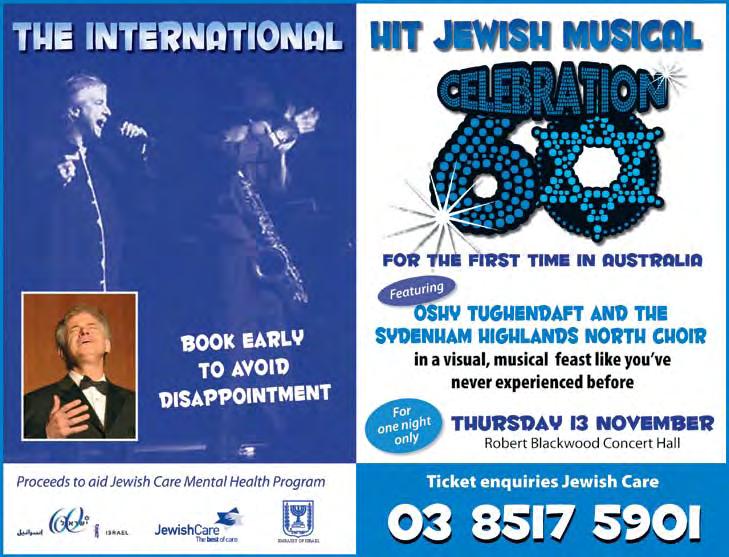
JHC Centre News 18
Conversations with Morris Gleitzman
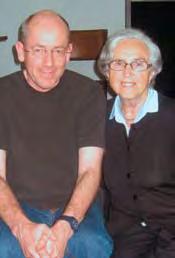
Frankie Pinch
Morris Gleitzman made a simple request to Penguin Books on the release of Then, his latest book for young readers – that the Jewish Holocaust Centre host the exclusive launch. So, on 3 June, the Centre’s Smorgon Auditorium was solidly booked for three sessions ‘In conversation’ with Gleitzman. Over 450 school children and 150 teachers from schools around the state attended.
Morris Gleitzman has developed a loyal junior fiction fan-base as a writer of twenty-seven previous works of funny fiction, including Doubting Thomas, Two Weeks with the Queen, Worry Warts and Give Peas a Chance. In conversation at the Centre, he revealed the shift that lead him to writing the not-so-funny Once, followed by Then, which took him nearly three years to research and write. Set in Poland, Then continues the deeply moving story of survival and friendship begun in Once. The narrator is the young and innocent Felix, who cares for the even younger Zelda in their journey through the Holocaust.
Gleitzman explained that his inspiration for the novels came from the story of the righteous Janusz Korczak, doctor and children’s author, who chose to die amongst his orphaned charges rather than accept the offer of freedom. Gleitzman said that his intention in writing the books was to express the tragic fact that while young people are always a part of war, they are never responsible for it. He also talked about his own heritage, his connection with the subject and his very personal search for his own roots. In the early part of the twentieth century his Jewish grandfather, who was originally from Krakow, left his family to immigrate to England. His entire extended family remained in Poland and was exterminated in the Holocaust.
In the afternoon session with teachers and librarians, host Larry Schwartz, a senior writer with The Age, questioned Gleitzman about issues of sensitivity in teaching primary students about the Holocaust. Gleitzman believes strongly

that children have the ability to deal with painful emotions and that the truth can only serve to strengthen their moral, emotional and spiritual muscle. Through fiction he encourages children to explore truths about the Holocaust for themselves, and his characters remind us of the power of the qualities of good.
At the launch, Gleitzman announced his plan to create a trilogy, hoping to complete the third book in the series within two years. He plans to carry out research at the Holocaust Centre for the next book. It is likely, he said, that Once and Then will be followed by Now
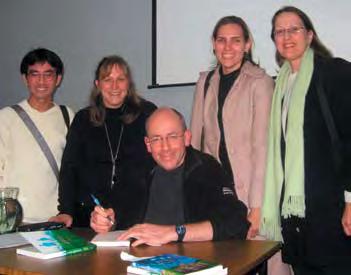
Morris Gleitzman’s novels Once and Then can be purchased in all good bookshops and are available locally at the Holocaust Centre and Sunflower Bookshop for $16.95 RRP.
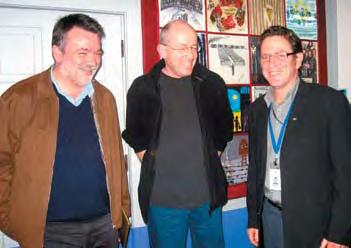
JHC Centre News 19
Morris Gleitzman with JHC librarian Rose Freilich
Signing books for Mt. Scopus College teachers & librarians
Larry Schwartz, Morris Gleitzman, Zvi Civins
EVENTS
Speaking to students
The Jewish Holocaust organised a memorable commemoration night on 1 May 2008 that brought together the Jewish and Armenian communities in Melbourne for the first time.

Dr Donna-Lee Frieze and Prof Peter Balakian lectured on the origins of the word ‘genocide’ and how the Armenian Genocide paved the way to the Holocaust and other genocides that followed.
Bernard Korbman, the Centre’s Executive Director, opened proceedings by discussing the Jewish interpretation of history, emphasising that history is a living, rather than a passive, experience. He stressed the need to have a reason to remember historical events, to prevent others from robbing one’s history and culture. Mr Korbman invited three Holocaust survivors to light six candles in memory of the six million victims of the Holocaust, and then invited a member of the Armenian community to light a candle in memory of the victims of the Armenian Genocide.
Dr Donna-Lee Frieze, a genocide studies scholar from Deakin University, spoke passionately about Raphael Lemkin, the person who first coined the word ‘genocide’. Frieze discussed the way Lemkin developed the concept over more than a decade from the time he first used it in 1933 and fought for the rest of his life to see genocide become a crime under international law. In 1948 Lemkin was instrumental in the adoption of United Nations Convention on the Prevention and Punishment of the Crime of Genocide.

Keynote speaker, Prof Peter Balakian, is a poet, author, genocide scholar and Professor in Humanities at Colgate University, New York, who was visiting Australia on the occasion of the 93rd anniversary of the Armenian Genocide. He has strong links with the Jewish community, having worked with Elie Wiesel and Deborah Lipstadt and spoken at the United States Holocaust Memorial Museum in Washington DC, the Jewish Heritage Museum in New York and the Holocaust Museum in Houston.
The Armenian genocide and the Holocaust Vahe
Kateb
The central theme of Balakian’s lecture was that the Armenian Genocide became a template to other genocides that followed, from the Holocaust to Darfur. Balakian drew attention to the fact that in 1915 the Young Turk government started something new and unprecedented. For the first time, Turkish leaders committed genocide in a modern way, using the government, bureaucracy, the military and modern means to eliminate a targeted minority group behind the screen of World War I. Two decades later Nazi Germany, using the screen of World War II, carried out the final solution of a hated minority –the Jews.
Shortly before invading Poland in 1939, Hitler said, ‘Who, after all, speaks today of the annihilation of the Armenians?’ Balakian argued that Hitler was inspired and emboldened by the Young Turks, who had systematically eliminated the Armenians and rid Turkey of its Armenian ‘problem’. Not only had this been the largest human rights crisis of the second decade of the 20th century, but merely two decades later the Armenians had been all but forgotten. Hitler learned a great deal about the Armenian Genocide because Turkey and Germany were allies during World War I and many high-ranking German officials and military officers later served in Nazi Germany.
Balakian described the Turkish denial of the Armenian Genocide as scandalous and bizarre and noted that Ankara spends millions of dollars a year in sanitising, rewriting and revising its own history. In this context, he reminded the audience of Elie Wiesel’s remarks that denial represents a double killing because it also strives to kill the memory of the event.
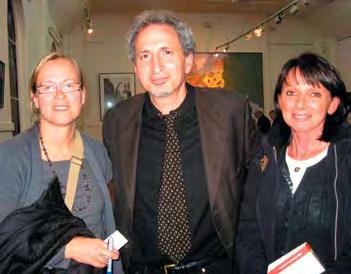
JHC Centre News 20
Member of Armenian community lighting commemorative candle
Dr Donna-Lee Frieze
Jayne Josem, Peter Balakian and Susie Kleid
Balakian explained how the Turkish government meticulously planned and carried out the genocide, creating a special organisation, responsible among other things for the formation of mobile killing units (referred to in the Australian press of the period as ‘butcher battalions’). He drew parallels with the creation of Einsatzgruppen in Nazi Germany for the elimination of the Jews.
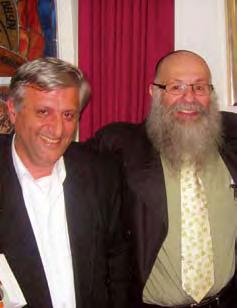
Ideology played an immense role in the elimination of European Jewry and the Aryan fantasies of a master race, said Balakian, were virulent motivating factors in the extermination projects of the Nazis. Similarly, Turks sold the idea of the extermination of Armenians with the idea of Turkey for the Turks. He described how German officers stationed in Turkey referred to the Armenians as ‘Christian Jews’, and noted that as early as 1915, antiSemitism in Germany was being transported and transposed on to the Armenians.
At the end of the evening, Bernard Korbman challenged both communities to work together to introduce the Armenian Genocide into the curriculum. He also invited descendants of the survivors of the Armenian Genocide to come to the Holocaust Centre and share their stories. Prof Balakian ended this special night with a reading of one of his own poems entitled ‘The Children’s Museum at Yad Vashem’.
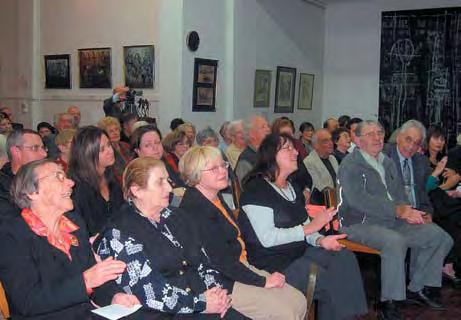
Celebrating Israel ‘60’
Frankie Pinch
On Thursday 8 May the Centre extended an open invitation to the Melbourne Jewish community to join in celebrating Israel’s 60th birthday. Survivors, family and friends gathered to celebrate this momentous anniversary.

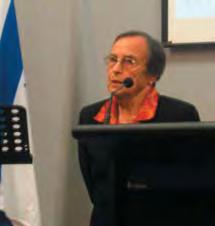
Sponsored by FBI Travel and the Child Survivors of the Holocaust Group, the event was an informal gathering that brought together many people from the community. Included were those who lived in Israel in 1948, Holocaust survivors who went from Europe after the war to Israel and played a role in the fight for independence, former March of the Living participants, families of the 2008 Australian March of the Living groups and members of the public, young and old.
The programme for the evening featured footage from the Centre’s extensive testimonies collection of Holocaust survivors who left post-war Europe’s displaced persons (DP) camps under perilous circumstances, often in fishing boats and illegal and rusty vessels via Italy, Cyprus, Egypt, Iran and other countries. Holocaust survivors Sarah Saaroni and Tuvia Lipson then spoke of their experiences, the military struggles of the Hagganah and Palmach before, during and after the War of Independence, and the historic proclamation of the State of Israel on 14 May 1948. The Centre displayed artifacts, medals, documents, uniforms and a handsewn Israeli flag made for the Israeli Navy at that time.
A telecast of particaipants in the Australian Student March of The Living, filmed by Sean Meltzer, documenting their experiences in Poland just prior to their arrival in Israel for Yom Ha’atzmaut was a highlight of the programme. Musicians Karen Feldman, Oded Gordon and Asher Ellazam entertained with Yiddish and Hebrew songs of the past and present, creating a memorable atmosphere enjoyed by all. A traditional schmooze and supper of delicious pita, falafel and Israeli salads was provided at the evening’s conclusion.
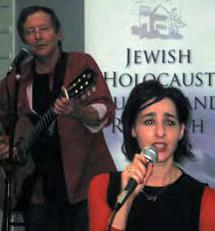
JHC Centre News 21
Vahe Kateb is Head of SBS Radio’s Armenian Programme in Melbourne
Raffi Ghazarian and Bernard Korbman
Karen Feldman and Oded Gordon
Sarah Saaroni
Survivors reunited with the JOINT
Frankie Pinch
Affectionately known as ‘the Joint’ and now officially the JDC, the American Jewish Joint Distribution Committee has been in existence for over 90 years. It played a pivotal role as the relief agency which helped survivors rebuild their shattered lives at the end of World War II. On 6 August 2008, the Jewish Holocaust Centre, together with the Jewish Museum of Australia, hosted a public programme which reunited survivors with the Joint. Held in the Smorgon Auditorium, the programme was held to support the Jewish Museum’s exhibition ‘Nationality: Stateless - Destination: Australia’ at the Gross Gallery.
Alan Schwartz AM, past president of Jewish Care, chaired the evening and welcomed Joint President Ellen Heller, CEO Steven Schwager, Board member Alan Rothenberg from New York and Overseas Ventures Head Solly Kaplinski from Jerusalem.

Associate Professor Mark Baker, Director of the Australian Centre for Jewish Civilization at Monash University, spoke of his survivor parents’ experience after the war. As an eighteen-year-old teenager, his father’s future relied heavily on the hand that reached out to help him and the theme ‘the Hand of Redemption’ was carried through the evening to highlight the amazing work of agencies like the Joint and the Jewish Welfare and Relief Society (now Jewish Care).
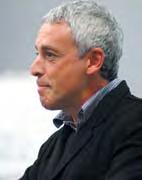
Jewish Welfare played a critical role in settling migrants after World War II and their work depended heavily on funding and support from the Joint.
Associate Professor Suzanne Rutland, Chair, Department of Hebrew, Biblical and Jewish Studies, University of Sydney, presented a historical overview of the Joint in an Australian context. She highlighted the Joint’s role in helping with the absorption of 25,000 Jews into Australia after World War II, as well as their assistance with the immigration of Egyptian and Hungarian Jews in the 1950s and Soviet Jews in the 1970s.
Max Zilberman and Bella Meylikh provided firsthand evidence of the Joint’s work in moving accounts of their journey to Australia, Max as a Holocaust survivor who came to Australia from Switzerland in 1949, and Bella, who arrived from Russia via Rumania in 1981, escaping the bitter anti-Semitism of the Soviet Union.
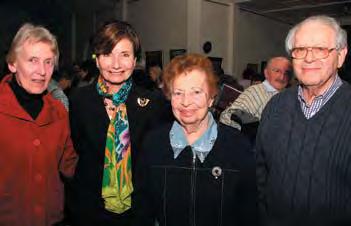
Freda Freiberg, daughter of Mina and Leo Fink, spoke about life in Melbourne during the post-war influx of Holocaust survivors and the role of her parents as tireless
community workers. The Fink family was instrumental in helping survivors settle into life in Melbourne, with Mina as the ‘hands-on’ carer and motivator to other women and Leo as fundraiser and negotiator. Freda spoke proudly of her late parents’ involvement, her father’s pet name of ‘Jewish Minister for Immigration’ and her mother’s special support of the ‘Buchenwald Boys’, one of whom was Max Zilberman, and her role in helping to found the Holocaust Centre.
Ellen Heller and Steve Schwager then explained the role and functions of the Joint today. The Joint’s mission is to rebuild Jewish life wherever it has been destroyed and currently has a presence in 66 countries around the world. A major focus is to support the needs of elderly Jewish survivors who have been abandoned by diminished communities. Currently, the JDC provides lifesustaining assistance to 188,000 impoverished Jews in the former Soviet Union and in Central and Eastern Europe. It is funded by private American support, international individual donors, the Israeli Government and Claims Conference funds.
Pauline Rockman, Jewish Holocaust Centre President, summed up the mood of the audience in her vote of thanks, giving praise to the ‘Hand of Redemption’ of the Joint, whose work has enriched the Melbourne Jewish community and so many others around the world. She also highlighted the need for Jewish organisations to work together, at the local as well as global level.
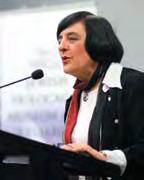
JHC Centre News 22
Freda Freiberg, Judge Ellen Heller, Bella Meylikh and Max Zilberman
Alan Rothenberg, Shale Stiller, Pauline Rockman, Judge Ellen Heller, Steve Schwager, Helen Mahemoff and David Prince
Associate Professor Mark Baker
Associate Professor Suzanne Rutland
Photo: Peter Haskin
Photo: Peter Haskin
Photo: Peter Haskin
Photo: Peter Haskin
Student March of the Living 2008
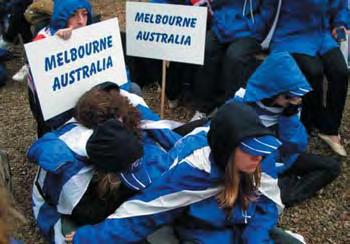 Zvi Civins
Zvi Civins
March of the Living 2008 was a powerful and moving experience. From Warsaw and the Umschlagplatz, our very first stop, to Nahalat Binyamin, the open air craft market in Tel Aviv two weeks later, and on every day and destination in between, students and adults shared a journey of intense historical, spiritual and personal meaning.
Isn’t it possible to learn about the Holocaust and Israel through any one of a thousand books, documentaries or museums such as our own? Of course, but being present at the sites of such suffering, courage and rebirth provides an intangible dimension of understanding that no book or museum alone can do. One can look at the musical score of a symphony and completely see the way the composer develops a musical theme, but it isn’t enough. One can hear a recording of the same symphony, but that is still not quite enough. When one hears, live, the orchestra playing the notes, then one can truly appreciate the music the composer committed to paper centuries earlier.
March of the Living is similar. In no way do our students, nor we, actually experience the Holocaust, or the birth of the modern State of Israel. But standing at
the ruins of the crematoriums at Birkenau, in the Rema Shul in Krakow, or in the room where David Ben Gurion proclaimed the establishment of the State of Israel, just to name but a few of the memorable places we visited,
is to feel the vibrations of history, just as one feels the vibrations of music in a concert hall.
The connection between the Holocaust and the rebirth of the State of Israel is a complex one. Nevertheless, the opportunity to experience the death camps on one day and the beauty of Tsefat (Safed) on the next made us all reflect on the importance of Israel. Sharing Yom HaShoah v’HaGevurah on the actual day of the march from Auschwitz I to Birkenau with thousands of Jews from around the world, and marching again to the Kotel on Yom HaAtzmaut, provided us all with an incredible connection across the continents and years.
And of course, sharing all of this with two inspirational survivors, Henry Neufeld and Joe Szwarcberg, made the trip even more memorable. These two men gave of themselves tirelessly throughout our time in Poland. We cried with them at Belzec and Birkenau as they shared their personal testimonies. We shared the simcha of Joe’s bar mitzvah in Jerusalem, the bar mitzvah he could not have in 1943.
March of the Living is a symphony of Jewish learning and living, of tears and joy, of sorrow and pride.

Don’t miss the chance to become a
through the Jewish Holocaust Centre Foundation. Join with Steven Spielberg, one of the Foundation’s Patrons, and ensure the on-going success of JHC.
Three levels are available and are payable over five years.

JHC Centre News 23
Zvi Civins and Gideon Reisner
Australian Student March of the Living participants
‘Partner in Remembrance’
Silver
MARCH OF THE LIVING
All donations are fully tax deductible Gold Partner $18,000
Partner $10,000 Bronze Partner $5,000 Each ‘Partner in Remembrance’ will be acknowledged. Further details are available from Helen Mahemoff, Chair of the Foundation t: 8922 8080 or 0417 323 595
My March Henry Buch
It seems like only yesterday that I packed my bags and was driven to the airport to begin a journey back to my past.
I came to Australia in 1948 from Marseilles. I had been in an orphanage on the outskirts of Paris and my mother, who had been liberated from a slave labour camp called Gorlitz, went in search of me. She walked four hundred miles from Leipzig to find me. I was a bewildered boy of around five years old who had never known a stable home with a family around me, so I was not willing to go with this strange woman, who assured me she was indeed my real mother.
I had up to then been hidden by a number of families. I was born in 1941 in the Warsaw Ghetto, where my family had a large textile business. The ghetto was being slowly emptied and there were regular round-ups, with many people transported to camps.
My family lived in a block of apartments where my uncle organized for our dwelling to have a false wall next to the kitchen. When the round-ups occurred, we all hid in the small area behind the false wall and, as I was so young, my mouth was taped up. The Nazis came but did not find us.
Unfortunately my father, Sevek Buch, was picked up outside our apartment one evening and was taken to a slave labour camp in Lublin. The family desperately tried to bring him back, but he nevertheless perished and is lying in a mass grave in Majdanek, which I visited on the recent March of the Living.
My uncle had a lot of contacts with the Polish police. He became a Red Cross representative and was able to move freely within and outside the ghetto, and he managed to save all our family. I was the first to go, wrapped up in a small paper parcel and passed through the gates, then given to the family of one of his Polish girlfriends, where I remained for a while. They had a daughter my age who was like a sister to me. Being blond and blue-eyed, I blended in with the family.
I was treated reasonably well, although not the same as the other members of the family. We lived in fear. I was told that once a German came in and bounced me on his knee saying, ‘This is a true Aryan beautiful child.’ Everyone held their breath. This was one of the many lucky miracles in my life. I was sent to a place in the country called Otwock and later another family took me in. Many times I was put into a cellar to hide, so I spent a lot of time alone in darkness. Later my uncle came and helped look after me.
Meanwhile, my mother was taken to a slave labour camp together with my uncle’s girlfriend (whom he later married), her mother and two sisters.
When the war was over my mother, grandmother, aunt and I were sponsored by a relative in Melbourne to come to Australia. My uncle chose to stay in Paris. The voyage on the ship was very traumatic as I encountered all the childhood diseases – measles, mumps and whooping cough – making my family very distressed.
When we arrived in Melbourne, we lived in Bacchus Marsh as our sponsor, Harry Spatt, had a stud farm there. We then moved to Parkville where I went to my first Australian school, Princes Hill. Not only could I not speak English, but I felt
and looked different and was intimidated by the teachers. I gradually integrated, and once I had mastered English, I was on my way and gained good marks.
My mother was a wonderful help to me as she never interfered, but guided me in the right direction and helped me with my schoolwork. She was a very important part of my life. She passed away last December at the age of ninetynine and a half.
My life has been most rewarding. I am married to Brenda and have two lovely children, Debra and Jason. I qualified as a physiotherapist and podiatrist and have been involved in many welfare and social groups. I am currently a councillor for the City of Glen Eira and I am also a volunteer with the Holocaust Centre.
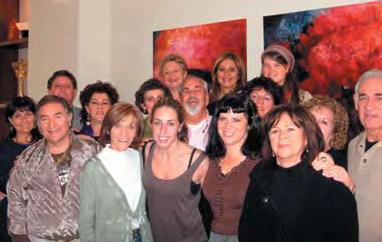
I owe a debt of gratitude to my uncle Henryk Bialylew, who died at the age of ninety-seven several years ago. He saved my life and all of my mother’s family. My mother’s sister, my Aunt Stefa, lives in Melbourne and, thanks to Uncle Henryk, there are now grandchildren and great-grandchildren.
Going on the March of the Living, back to Poland, gave me a sense of closure. I discovered that the other members of the group were interested in my story. For the first time I felt that I was not alone; I felt included and appreciated. Poland for me brought a sense of meaning and understanding to many of the photographs and memorabilia with which I grew up, but to which I felt no connection. This then became the link to my past and gave meaning to my life in terms of my identity and my relationship with my life in Australia. Even though I am happy with my life, I still ponder what life could have become had the Holocaust never occurred. I especially wonder what it would have been like to have a father and siblings.
I recently visited the people in Poland who hid me and saved my life. In spite of people telling me that Poland was anti-Semitic and a cold, grey and miserable place, I found a modern city with beautiful buildings, well-groomed and polite people, in spite of bureaucracy being rife. There were arcades and shopping centres just like in any other major city. The countryside was green and flourishing. After the March of the Living tour, where I saw my father’s grave, all the death camps and the cities which I had read about, I lived for a number of weeks with my adopted sister. The family now lives in Lodz and once again I was part of it. My life has now come a full circle.
This testimony is written in the memory of my mother, Sara Buch/Jazwinski, my father, Sevek Buch, and my uncle, Henryk Bialylew.
JHC Centre News 24
Adult March of the Living 2008 Reunion, Henry Buch second from left
Opening the heart:
The Adult March of the Living in Poland
Eve Recht
It is cold and bleak, but the heart of the March of the Living shines bright in this photo. Here we are, almost at the end of our week there, standing crowded in the rain on the green hill that was once part of the Plaszow labour camp. We are very still, intensely listening, totally focused on our passionate and wise guide, Tali, who is teaching us, guiding us towards understanding, acceptance, the beginning of wisdom. Tali is once more weaving together the personal and the publicly historic, the horror and the hope, the past and the present. We stand especially close as Tali tells us about the madness and horror of this camp, and about the enigmatic Oskar Schindler, for this time she is telling her own story, the miracle of her father and her uncle being on Schindler’s list. We breathe as one with her, and we are washed by our tears and the rain.
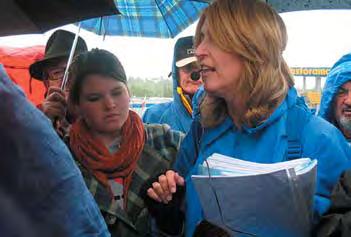
When I think back, I had no idea that the start of my journey – the decision to join the March of the Living with my two sons – would bring me to this tragic green hill; lead me to insights both painful and exhilarating; and give me the grace of belonging to a group that began as a hundred disparate individuals and became a community, a community of shared history and sorrows, who supported and nurtured each other, who listened and learned together, prayed and marvelled together, wept and laughed together.

The best thing I had done to prepare for the March was to collect leaves from eucalyptus trees around my home. These trees stand courageous and tall in the Australian soil and nourish my Australian heart, so I decided to take a small bag of leaves with me. I had seen a photo of flowers placed in one of the ovens of Auschwitz, and I had heard that some March of the Living participants planned to speak about their families in that hideous place, that overwhelming icon of the Holocaust. I thought that I too would like to pay tribute there. The eucalyptus leaves would be a symbolic return, brought back to Poland by the Australian-born child of parents who had fled as refugees.
But as soon as we started the tour, on a wet cold afternoon at the Warsaw Cemetery, I knew where to place my leaves and tell my story. Right there, in the cemetery, near the streets and the ghost-streets of the Warsaw Ghetto, where most of my mother’s family was murdered, and where my father’s story is an aching sad emptiness. So I spoke, and left my leaves, and started to grow.
This was an opening, a new beginning. I was moving from the abstract to the real, from the weighty dread of the unknown to the cleaner pain of sorrow, from notwanting-to-know to being strengthened and enriched by knowledge.
And so ‘Auschwitz’, as the ultimate symbol of an unknowable terror, an unutterable loss, was dissolved and replaced by the reality of the place and its history. I
was there, I faced the deep blackness and I survived. It is of course a place of absolute evil, but I am strengthened by being there, treading the ashen soil, standing in the women’s barracks, staring into the ruined gas chambers and crematoriums close by the Birkenau forest. I am strengthened also by its present existence, as place of pilgrimage, as museum, as a cemetery where people weep and mourn and vow ‘never again’.
I am strengthened too by hearing others’ stories and by finding some of my own. The realisation that I had never thought of myself as a granddaughter was shocking and painful, but also a powerful gift. My parents gave me very little of their past, of my history. It must have been too heavy, a burden unbearable on their gruelling journey over half the globe and seven long years to reach the haven of Australia, land of my eucalypt trees. But now that I see the loss, I can start to reclaim my grandparents, my family, real people who lived rich and diverse lives in that fertile land.
After the March, Aaron, Noah and I stayed in Warsaw for a few days and, blessed by our shared experience, we went back, back to the ghetto, back to the cemetery. This time the sun was shining and it was quiet. We sat and talked, lit a candle. We walked my mother’s streets and, in the sunny mid-afternoon, rang her at home in Melbourne to compare the rebuilt Warsaw with the landmarks of her pre-war life. And at the end of our long and meaning-full day, we had coffee and cake in that city where we had begun to feel at home.
That’s what the March of the Living was – an exploration of the past and the present, of good and evil, the mundane and the inconceivable, the vast plains of history. An opportunity to reflect and to mourn and, most of all, to celebrate the resilience and courage of the human heart.
JHC Centre News 25
‘Whenever a text is spoken, whether prepared or improvised, and listened to, we become a community of present contemporaries, people breathing together.’
Ursula Le Guin
Aaron Saks, Eve Recht and Noah Saks at the Rapoport Memorial in Warsaw
Jordana Milstein and Tali Nates, Plaszow Concentration Camp
Survivors social group begins
Katy Meltzer
On Thursday 5 June, the Holocaust Centre launched a social group for retired survivor guides and volunteers. The Centre’s management views the group as an important way of acknowledging survivors who in the past have contributed so much to the life of the Holocaust Centre. The eight session pilot programme has been funded through three generous donations: the proceeds of Maurice Kohn’s 60th birthday simcha held by Fay and Maurice Kohn; the proceeds of Jack Ginger’s 60th birthday simcha held by Gita and Jack Ginger; and a donation made by the Adult March of the Living.
The group of up to twenty retirees meets every fortnight at the Centre and aims to give survivors an opportunity to enjoy a regular social gathering in a stimulating and nurturing environment. In the sessions to date, the group has been introduced to the current staff and has heard about the upcoming museum upgrade, participated in lively discussions and gentle movement to music sessions, listened to interesting guest speakers and has been on an excursion to Chinatown and the Chinese Museum. Each
session includes transport and a kosher lunch provided by the Centre.
If funding is obtained to extend the group past the pilot programme, the Centre intends to broaden the group to include the wider community of Holocaust survivors. The group is currently facilitated by Katy Meltzer, the daughter of a survivor and a psychologist with a professional background in aged care. Able assistance is provided by a dedicated group of volunteers – Max Wald, Barbara Sacks, Marieke Stork, Matthew Gerstgrasser and Lyn Flax.
Introducing Rae – our Volunteer Co-ordinator
Volunteers are the lifeblood of our Centre. Our Volunteer Co-ordinator, Rae Silverstein, is herself a volunteer and it is her role to recruit and support volunteers at the Jewish Holocaust Centre. We now have around 160 volunteers – 70 volunteers who do a myriad of tasks, playing a vital role in all facets of the Centre’s work, and almost 90 trained volunteer museum guides.
Rae finds it very rewarding to meet the many like-minded people who are willing to give so generously of their time. She is constantly challenged to match each volunteer’s skillsset with the needs of the Centre. Volunteers are involved in office administration support, reception, updating the database, IT support, assisting with organising events and working with a group of retired survivor guides and volunteers.
There are also many volunteers who provide support to the Centre’s various departments – Archives, Library, Testimonies, Education, Development and Special Projects.
The museum guides, who are of all ages, include 25 Holocaust survivors, working with children of survivors and Australian-born volunteers. Currently, the Centre is well supported in this specialised area, with the next training course for guides not due to be offered again until 2010. Volunteers come to the Centre weekly, fortnightly or monthly, or whenever they can. If you have any time to volunteer and feel that you can contribute to the Centre, Rae would love to hear from you. You can email her at rmsilverstein@optusnet. com.au or phone her on 0408 575 477, or at the Centre on 9528 1985 (only on Tuesdays).
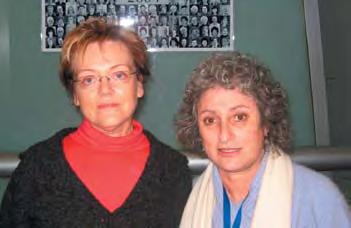
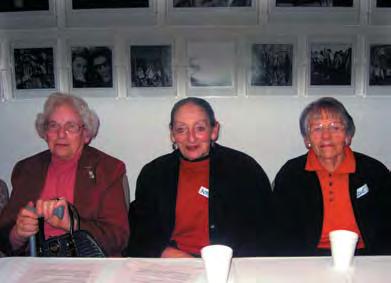
City of Glen Eira honours volunteers
On 15 May 2008, ten hard-working volunteers were honoured by the City of Glen Eira for their contribution to the Centre. Mayor Steven Tang presented them with a Volunteer Recognition Scheme Award at a private ceremony at Glen Eira Town Hall held during National Volunteer Week. JHC’s 2008 recepients are:
Mr Bill Anderson 2000 hours
Mrs Judy Berman 1000 hours
Mrs Caroline Bryce 1000 hours
Ms Elaine Davidoff 1000 hours
Mr Paul Grinwald 1000 hours
Mrs Kathy Janovic 1000 hours
Mr Leon Jedwab Special Service
Ms Sue Lewis 1000 hours
Mrs Eva Somogyi 1000 hours
Mr Fred Steiner 1000 hours
Cesia and Abe Goldberg were also awarded Special Awards for their 10 years of service to the Kadimah.
JHC Centre News 26
Anne Eisenbud, Doreen Amster and Rosie Bruell
VOLUNTEERS
Mary Stawski and Rae Silverstein
Bep Gomperts is a valued volunteer in the Archives Department at the Jewish Holocaust Centre. Since this story came to light early in 2008, the Centre has followed Bep on her emotional journey back to Holland to honour those who put so much at risk to help her.

In 1942, when Bep Gerritse was four-years-old, she and her mother, Jeanette, went into hiding. For the next two years, they survived life in the Netherlands by being hidden in various places across Amsterdam and the seaside area of The Hague. Her father, Abraham, had been picked up in a razzia (raid) in the Dam Square in Amsterdam on the day that the family was to leave for hiding. Bep and her mother were never to see him again.
In April 1944, Bep was separated from her mother and, through the co-operation of the Dutch Reform Church and an underground cell, was hidden and fostered by Johannes and Elisabeth Lugtigheid in Heemstede. Being elders of the Church, Bep’s foster family was well connected and under no immediate suspicion. However, not long after her arrival, Bep had to be moved as the Lugtigheids dutifully hosted a German pilot intern, putting her position at risk. She was fortunate to find temporary shelter with a school friend, Cornelus Huisman, and his family in the dunes area beside the Amsterdam Waterworks, an area now documented as a well-known hiding area.
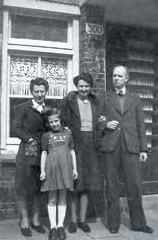
Bep’s memory of the Lugtigheids is that they were extraordinarily caring people, who were unable to have their own children and openly referred to her as their niece. They treated her like a princess, spoiling her with beautiful homemade toys for occasions like the Dutch Saint Nicholas Fest on 5 December. Bep also clearly remembers feeling blessed to have had her sixth birthday wish of attending the local village school fulfilled.
After the war, Bep was reunited with her mother, who had returned from Westerbork transit camp in east Netherlands. Together they moved back to Amsterdam where Bep grew up, met and married Hermann Gomperts and had three children. The relationship between Bep and the Lugtigheids remained strong. Bep never forgot the protection and care the Lugtigheids gave her as a child and she was constantly driven to do more to recognise their kindness.
In 1979, the Gomperts family migrated to Australia and Bep lost contact with the Lugtigheids. On a return trip to the Netherlands in the 1990s, however, Bep placed a public announcement in a magazine in the hope of finding lost
Bep’s gift: Righteous Amongst the Nations honour
friends from the time that she was hidden as a child. Within three weeks, Bep received a letter from Hannie Hoff-Lugtigheid, the niece of her foster parents. Elisabeth and Johannes had died and Hannie and Bep discussed a plan to honour their memory.
In 1997 Bep was working at the Holocaust Centre in Melbourne and decided to honour the Lugtigheids as ‘Righteous Amongst the Nations’. Although it took many years to organise this, the process involved resulted in an emotional reunion with Cornelus Huisman, Bep’s school friend whose family had briefly given her refuge.

Finally, on 15 May this year, Bep and her family attended the Yad Vashem ceremony at the Jewish Historic Museum in Amsterdam to honour the Lugtigheids. A plaque was presented to their niece, Hannie, in the presence of Bep’s friend Cornelus Huisman and his wife. Other dignitaries who attended the ceremony included Elie van der Wiel, wife of Dutch resistance leader Frans van der Wiel, and poet Mariette Elliott-Kleerekoper.
Following the ceremony, Bep said, ‘I am very happy that I could do something for these wonderful people who were so good to me during the war. I only regret that I could not do something for them whilst they were still alive. But I am now at peace seeing them receive their rightful honour, even though it is posthumous.’
JHC Centre News 27
Bep Gomperts, Hannie and Fred Lugtigheid
Bep Gomperts, her son, and Marlies, Hannie and Fred Lugtigheid at the Yad Vashem ceremony in Amsterdam
Jeanette and Bep Gerritse, Elisabeth and Johannes Lugtigheid
The Friends of the Jewish Holocaust Centre recently held an AGM and elected our committee: Anita Bartfeld (Young Friends), Sue Benkel, Lulek Bron, Elly Brooks, Caroline Bryce, Judy Goldman, Annette Hayman, Adam Kreuzer, Silvana Layton, Sue Lewis, Rosi Meltzer, Susan Onas and Alice Peer.
We are delighted that our membership continues to grow. Membership subscriptions are important in supporting JHC, as are our raffle, sales of the Entertainment Book and numerous social fundraising functions.
Kate Rosenberg, recipient of a Meyer Burston scholarship, worked as an intern at Galicia Jewish Museum in Krakow and gave a wonderful presentation to a packed hall at the
Friends of the Jewish Holocaust Centre Elly Brooks
Centre in July. She is now continuing her studies in Israel and we look forward to hearing about her experiences when she returns.
Friends allocated $5000, matching a Heritage Victoria grant, for the Centre’s curator to work on identifying interesting correspondence in the Centre‘s collection. After translation and research into the life stories of the letter writers, the material will be compiled into presentations and made available to the public. Friends also assisted in providing funds to finance the Centre’s education director.
We continue to plan social functions and to support the Young Friends group. Next year, we are delighted to be a part of the Centre’s 25th Anniversary celebrations and to host a 3rd Seder for survivors in April.
It is only through your support and membership that Friends can continue to undertake projects to raise funds and ensure the Centre’s continuing diversification in Holocaust awareness and education. So, if you are not currently a member, please fill out the membership form below and return it to us. Our new committee would also welcome new members to assist us in our endeavours, so please contact Elly Brooks on 0409 002 485.
Help support the activities of the Centre by becoming a Friend
Friends of the Jewish Holocaust Centre
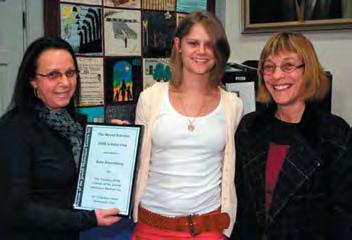
JHC Centre News 28
Lyla Burston, Kate Rosenberg and Elly Brooks
F RIENDS OF THE J EWISH H OLOCA u ST C ENTRE M EMBERSHIP A PPLICATION F ORM (2008—2009) Title _____ First Name ________________________________ Surname ______________________________________________ Address ____________________________________________________________________________________ postcode __________ Daytime Contact Number __________________________ Mobile __________________________ E-mail ___________________________________________ Cheque payable to:
Jewish Holocaust Centre Credit Card: Visa Mastercard Diners Amex Card No: Expiry Date: ________ /________ Cardholder Name: _________________________________________________________ Signature: ________________________________________________________________ $25 Single $45 Family $15 Single Concession $ ________________ Tick here for Young Friends (under 35) $ ________________ DONATION (All donations over $2 are tax deductible) $ ________________ TOTAL AMOuNT $ ________________ Please send payment to: Friends of the Jewish Holocaust Centre 13-15 Selwyn Street, Elsternwick 3185 Telephone: 9528 1985 Fax: 9528 3758
www.jhc.org.au PAYMENT DETAILS FRIENDS ANNuAL MEMBERSHIP
Friends of the
Email: friends@jhc.org.au Website:
FRIENDS
Why do we go to Poland?
Kate Rosenberg
The title to this piece is an old one – one not my own. It is a question which was asked by author Jack Kugelmass and it is one which has begun to burn holes in my mind. Why is it that Jews from across the globe are all running to visit Poland, running to take a ‘holiday’ of emotional and sometimes painful experiences?
Sometime in the middle of last year an overwhelming desire to live in Poland came over me. I didn’t expect the feeling and, when I first felt it, I had no intention of indulging in it. Nevertheless, less than a year later I found myself in the cold streets of Krakow with a list of apartments to inspect and a handful of Polish words to help me do so. It was not a one-week visit I sought, but a longer, more meaningful experience of Polish life and culture. I wanted to explore what it meant to be a Jew of full-blooded Polish heritage. I wanted to learn what was happening in the Jewish communities of Poland, a country often labelled the largest Jewish cemetery in the world. So there I went, participating in a four-month internship at the Galicia Jewish Museum in Krakow and learning what it means to live like a Pole.
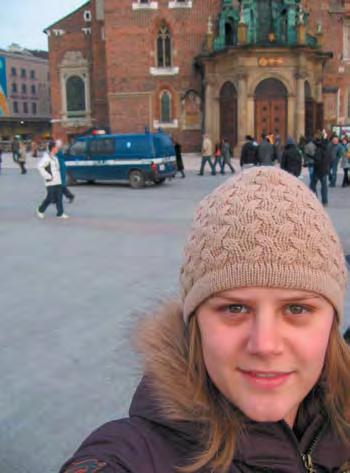
I saw many Jewish (and non-Jewish) tourists come and go from the city. Auschwitz is the most visited ‘Holocaust site’ in Poland and anyone visiting Auschwitz usually does so as a day trip from Krakow. The Jewish Museum is in a side street just off Szeroka Street, the centre of the Jewish district called Kazimierz, and my vantage point there enabled me to meet many of the Jewish groups who visit Poland.
I met large Israeli groups and groups of Jewish American teens with Israeli flags slung over their shoulders. I saw groups of Jewish adults on tours with their synagogues. I encountered couples and families on private tours, attempting to reconstruct an image of their families’ history in Poland. The array of options to travel ‘Jewish Poland’ is truly astounding and so many Jewish communities and individuals around the world are assembling their own tours.
So I return to my original question: Why are we going to Poland? I have come up with a range of answers to this seemingly simple question. Some of them I like, but there are others of which I am weary.
Sometimes there were groups whom I found to be on a genuine mission to discover their family history. They came to see the places where their parents and grandparents grew up. They came to understand what it meant to be a Polish Jew before the war and to see what it means now. I value this reason.
Other times there were groups who came to link their Jewish identity and essence with the Holocaust. They came with big Israeli flags and sang songs in public places and somehow felt more Jewish in doing so. For some reason, they felt much more Jewish after seeing the sites of mass destruction and thinking about how European Jewry was a hair’s-breadth away from annihilation. I am not sure why they would want their Jewish identity, something which should be built on positivity, to be strengthened by such a tragic event.
So why do we go to Poland? To mourn? To remember? To understand? To learn? To be angry? To be sad? To celebrate what was there before the war? To discover what is there now?
I think our reasons are usually a combination of these aims. If we are to gain anything useful and constructive from these visits, it is imperative not to mix the wrong ingredients. Anger and sadness, for example, are not useful emotions for making progress in the way we understand the Holocaust or how we want future generations to interpret its meaning. Similarly, only aiming to celebrate what was there before the war and learn about the Jewish communities there now will not lead us any closer to understanding the dreadful war years in between.
It is imperative that the lessons of the Holocaust are not misappropriated in what is fast becoming the ‘Shoah business’. Visits to Jewish Poland could soon become a part of this ‘business’ if they are poorly planned and used inappropriately. Although these trips can be essential to our learning about the Holocaust, we must understand ourselves as Jews and our aims in visiting Poland prior to setting foot on Polish soil. A short sojourn in Poland and the Holocaust should never be used as a crutch upon which to base our Jewish identity.
JHC Centre News 29
Kate Rosenberg in Krakow
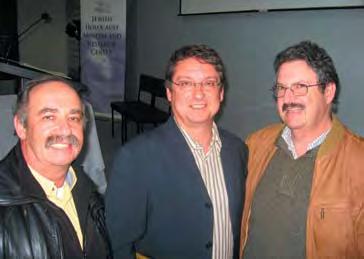


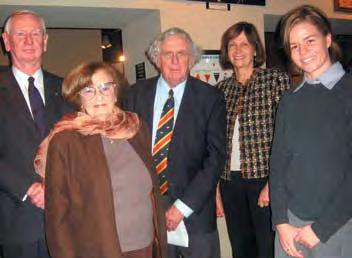
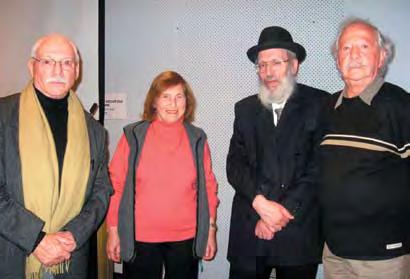
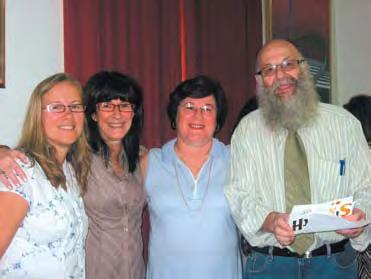
JHC Centre News 30 SEEN AROUND THE CENTRE
Representatives from the Ian Potter Foundation visited the Centre in May. Pictured, left to right, are Sir Daryl Dawson, Museum guide Kitia Altman, Professor Geoffrey Blainey, Mrs Janet Hirst, CEO Ian Potter Foundation, and Caitriona Fay, Education Program Manager
Marlies Brosch, wife of the Deputy Consul of Germany, second from right, introduces her German Conversation Group to the Holocaust Centre
Mazeltov reception for Phillip Maisel, Head of Testimonies, who received of an Order of Australia Medal (OAM)
Jayne Josem, Debra Stiebel, Robyn Fetter and Bernard Korbman at Bernard’s 60th birthday celebration
Alex Dafner, JHC Vice President; Prof John Efron, Koret Professor of Jewish History, University of California, Berkeley; and Dr Jack Felman
Max Rose, Sonya Kempler, Pinchas Kornfeld, visiting Head of the Belgian Jewish Community, and Henri Korn meet at a Belgian community gathering in the Marejn Auditorium in August
Victorian
Pauline Rockman, David Prince, Marsha Thomson MP, Abe Goldberg, Rosa Krakowski, Helen Shardey MP, David Morris MP, Sue Pennicuik MP, Back
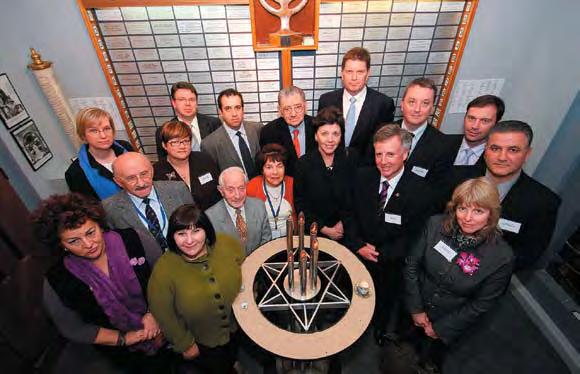
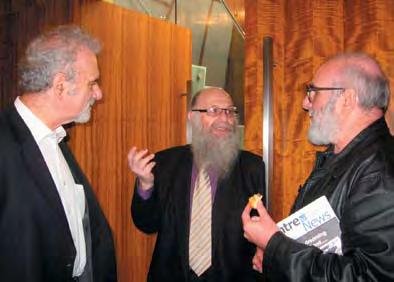
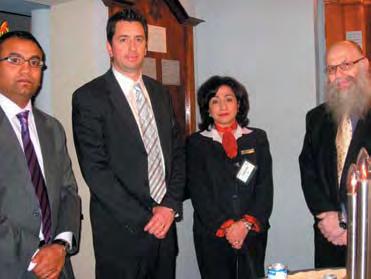
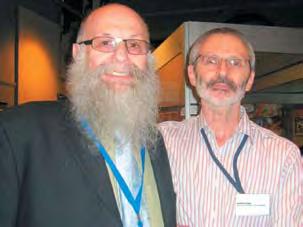
Fiona Richardson MP, Jenny Lindell, Speaker, Evan Thornley MP, Martin Pakula MP, Willie Lermer, Ted Baillieu, Leader of the Opposition, Martin Foley MP, Collin Brooks

JHC Centre News 31 SEEN AROUND THE CENTRE
NMIT film students, Project Leader Simon Aubor, with helpers Matt, Matt and Yianni complete filming at JHC in September
Contributors Louis Roller (left) and his brother Albert (right) with Bernard Korbman, at JHC’s French Resistance exhibition in August
Westpac Executives, Venkat Rajendran, Richard Young and Vicki Miriklis, with Bernard Korbman, during a visit to the Centre
Bernard Korbman and Jeffrey Zygier meet Victorian State Parliamentarians in June
Parliamentarians at the Centre. Front row from left:
row from left:
MP, Telmo Languiller MP
Photo: Peter Haskin
New Acquisitions
Ursula Flicker
The following are additions to the collection from March to June 2008:
1. ‘Jude – Warschau’.
Metal stamp from Warsaw Ghetto with the wording

Donor: Mr Martin Szwarc
Copy of Polish monthly 2. Kurier Polski with article on ghetto uprising, poem by Wladyslaw Kakol.
Donor: Mr Symcha Burstin
Gold pocket watch, together with gold Napoleon
3. medallion and ornamental ceramic dish, with a typed letter of explanation about the background to the donated items.
Donor: Mr Huibert Schroor
4. for show conducted at Westerbork; book sketches by Henri Pieck re Buchenwald Concentration Camp.
Article re Westerbork Concentration Camp; programme

Donor: Mr Mark Hermann Lissauer
Theatre poster from Poland for production about the 5. Warsaw Ghetto.
Donor: Mr Robert Nowak
Box containing photographs comprising 6. The Auschwitz Album.
Donor: Mrs Katharina Kont
Framed edition of newspaper 7. The Stars and Stripes
Volume 1, edition 34, dated 8 May 1945 with the headline ‘Nazis Quit – Doenitz gives order’.
Donor: Mr Zvi Civins
3 Photographs – 2 taken at time of signing of Nazi 8. surrender and 1 taken at time of liberation of Dachau Concentration Camp.
Donor: Mr Maurice Pelcman
Testimony in Yiddish, with English translation provided, 9. entitled The Furniture Camp under the Management of Machel (Michael) Birenzweig.
Donor: Mrs Sulamit Kogan
DVD entitled 10. World War II – The Battle of China & War Comes to America.
Donor: Mr Joseph and Mrs Marie Klarich
Correspondence and documentation 1938-1943 of 11. donor’s late parents after leaving Germany and arriving in Australia.
Donor: Mrs Evelyn Marcuse
Correspondence with, and articles and other 12. documentation about, ‘Righteous among the Nations’ Jan Karski.
Donor: Mr Leo Greenberg
Germany No. 2 (1939), 13. Papers concerning the Treatment of Germany Nationals in Germany 1938 – 1939, presented by the Secretary of State for Foreign Affairs to Parliament by Command of His Majesty.
Donor: Ms Carolyn Tomkins
Copy of testimony in two parts in Yiddish given by 14. Szyja Margolis, presented on 14 May 1947 to Jewish Historical Institute in Warsaw, Poland. Also copy of certificate No. 2889 International Information Dachau issued 22 June 1946.
Donor: Mrs Rosemary Benkemoun
17 booklets containing plays in Dutch by Jewish 15. playwright, Mr A Bromet, who perished in the Holocaust.
Donor: Ms Zsuzsi Hartman
Box of 32 photographic slides of concentration camp 16. images.
Donor: Mrs Lucy Dawn Ward
Copy of booklet entitled 17. When Hitler stole my Family, a memoir by Berti Burger, 9 November 1925, by granddaughter Stephanie Verstandig
Donor: Mr and Mrs Berti and Mary Burger
Series of documentation concerning the efforts to 18. trace whereabouts of victim of Hungarian deportation, Ida Spiegler
Donor: Mr Steve Klein
Copy of photograph of Holocaust Centre guide, Fred 19. Steiner, one year old in 1929, surrounded by his grandparents, parents, aunts and uncle. 15 years later the grandparents, 2 aunties and uncle were killed in the Holocaust.
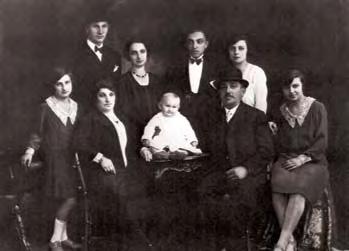
Donor: Mr Fred Steiner
The JHC Collection is a vital repository of Holocaust-era material. Artefacts and documents are carefully catalogued and stored in a state-of-the-art temperature-controlled facility to ensure their preservation for future generations. The JHC invites members of the public who have precious items related to the Holocaust to consider donating their material to our Collection for safekeeping.
Fred Steiner as a baby, surrounded by his family, 1929
COLLECTIONS
Metal stamp from Warsaw Ghetto with the wording ‘Jude – Warschau’
JHC Centre News 32
Stories from the Collection
Dr Julie Fenwick, Kathy Janovic and Jayne Josem
The Centre has a new temporary display on Jews who fought in the French Resistance. It features stories, photos, documents and medals from six resistance fighters: Mauritze and Bernard Roller, Sam Leber, Maurice Funk, Dr Jacques Adler and Max Drajer. In the last issue of Centre News we featured the Roller family story and here we focus on another two French fighters who have donated material to the Centre’s Collection. We are extremely grateful to Renee Coopersmith for loaning material related to Maurice Funk, and to Madeleine Leber who has loaned the Centre Sam Leber’s memorabilia for this display.
Dr Jacques Adler
Jacques Adler was born in Paris in 1927, the son of Polish immigrants. In May 1941 Jacques’ father, Simon, was arrested by the French authorities and sent with thousands of other Jews to Beaune-laRolande transit camp. He was later sent to Auschwitz and did not survive.

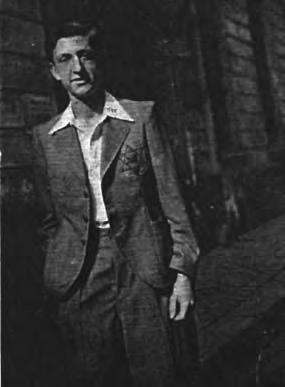
In 1942 Jacques joined a resistance group, Union des Juifs pour la Resistance et L’Entr’aide (UJRE). He started working in a factory where the underground sabotaged garments manufactured for the German army and tried to disrupt the production process. The Jewish workers were later deported to camps, but Jacques avoided this by moving into full-time resistance work. His mother and sister went into hiding, where they remained until liberation. In his new role Jacques spread word about the danger of staying at registered addresses, recruited young people for resistance work and raised funds.
A few weeks prior to the liberation of Paris, Jacques’ group was accepted into the French Army. Some two hundred former UJRE members participated in an uprising launched in August 1944, where they attacked German positions and manned barricades. Paris was liberated at the end of August.

After the war Jacques, his mother and sister decided to immigrate to Australia, arriving in March 1947.
Max Drajer
Max Drajer was born in 1919 in Gdansk and moved to Paris in 1929. In 1940 Max joined the French army and, following the German invasion, his regiment narrowly avoided capture. After recuperating from a shrapnel wound, Max traveled to the unoccupied southern zone. He located his family who had fled to Toulouse and he enlisted in the small Vichy army. In November 1942 the German army overran and disbanded the Vichy army and occupied Southern France. Fearing for their safety as Jews, Max organised false identity documents for the entire family. Max and his brother were recruited to the Resistance where they worked as couriers and later, smugglers, assisting Jewish children to cross the border into Spain. His group saved over two hundred children in a three-month period.

The Drajer family then moved to a small town near Valence in the Italian zone. Their next refuge was in the mountains of Village Saint Melanie. Max worked to support the family while his brother worked for a local unit of the Maquis.
When the war ended Max returned to Toulouse where he met and married his wife Regina. They had two daughters, Sylvia and Mido, and stayed in France until 1949, when they finally received immigration papers to Australia.
Young Max Drajer in uniform
Jacques with yellow star on his jacket, 1942
Jacques Adler, centre, with fellow partisan fighters
JHC Centre News 33
Max Drajer’s false identity card
State Members of Parliament visit Centre
Marsha Thomson, MP
After a Member of Parliament from the Opposition used the term ‘Gestapo’ in a speech in Parliament, Marsha Thompson MP, approached the Jewish Holocaust Centre to arrange a special visit to the Centre for politicians from all sides of the House. Although he apologised immediately, Marsha, who is the only female Jewish Member of Parliament, took offence to her colleague’s reference. She felt that he did not understand that the term ‘Gestapo’ was not just personally offensive to her, but it would be offensive to people outside the Parliament who had been affected in some way by the Nazi regime.
During the visit, there was discussion about the use of language, in particular the number of anti-Semitic remarks made by people involved with political organisations. Centre Director, Bernard Korbman, pointed out how language goes much deeper than political correctness. Our politicians, as the representatives of the people, hold in their hands the ability to unite the ethnic groups that make up our community and allow all of us to build on our dreams and share in the Australian ethos. However, through insensitive or callous use of language, they equally have the ability to shatter the dreams of those ethnic groups which make up the rich tapestry which is Australia.
On 17 June 2008, a number of MPs from most of the parties represented in the Parliament visited the Holocaust Centre and had the opportunity to meet with Holocaust survivors, tour the museum and listen to why it is relevant to always remember the effects of the Holocaust. I would like to take this time to thank Bernard Korbman and also the survivors who attended: Rosa Krakowski, Willy Lermer, David Prince, Sonia Wajsenberg, Halina Zylberman, Moshe Fiszman and Abe Goldberg, all of whom gave of their time so that we could learn about their firsthand experience of the Holocaust.
It is important for members to take the time to have a look at the museum. There is a great lesson in tolerance to be learnt from a visit to the Holocaust Museum. It is an opportunity to see why we must fight continuously to ensure that we need to nip intolerance in the bud.
I know that for those who attended, it was a worthwhile experience.
Many learnt the reasons why we must continue to talk about the Holocaust in our history lessons at school and why adults should take the opportunity to learn about its effects. It also provided a lesson in survival, about people getting on with their lives after the Holocaust and making a difference to the world.
Australian Friends of Yad Vashem find new home at JHC
The Australian Friends of Yad Vashem (AFYV) is very pleased to have its first office in Australia at the Jewish Holocaust Centre, within the Education and Research wing.
AFYV was established in March 2005 to coincide with the opening of the new Holocaust History Museum at Yad Vashem, Jerusalem. It exists to support the programmes and activities of Yad Vashem and is involved with the collection of Pages of Testimony through the Names Recovery Campaign, as well as facilitating visits to Yad Vashem by individuals and groups.
AFYV invites members of the community to become Friends of Yad Vashem and become involved in activities such as the Names Recovery Program, and to participate in visits to Yad Vashem.
Communal figure Johnny Baker has been the inaugural Honorary President of AFYV since its establishment and Deon Kamien was appointed the Executive Officer in late 2006. Deon and Johnny are looking forward to further developing the important partnership between the Holocaust Centre and Yad Vashem, as well as working closely with other community organisations.
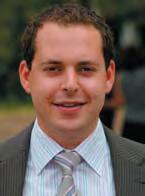
The Board and JHC Executive Director, Bernard Korbman, are delighted to welcome the AFYV to the Centre family and regard the association as a natural progression and extension of the Holocaust Centre’s activities. Korbman added, ‘The world-wide Holocaust Education fraternity is a close knit one and to have the added strength and enthusiasm of AFYV associated with the Centre, will add vigor and greater resources for all our programmes.’
To contact AFYV, call Deon Kamien, Executive Officer, Australian Friends of Yad Vashem at the Jewish Holocaust Centre, t: 9528 1985 or 0430 028 946, e: exec@afyv.com.au.
JHC Centre News 34
Marsha Thomson is State Member for Footscray and Parliamentary Secretary, Industry and Trade.
Deon Kamien
The Jewish Holocaust Centre is encouraged by the increased support and involvement of young people across the community in all aspects of its development. From guides to visitors, to volunteers and donors, the Centre has recently seen many new and young faces coming through its doors to champion the mission originally established by Holocaust survivors.

Both girls and boys as B’nei Mitzvot are also choosing to mark their s’machot in particularly meaningful ways. Recently, for example, in lieu of gifts, Elysha Segal
Thank you Elysha
chose to donate the entire proceeds of her Batmitzvah to the Centre in a carefully planned and considered way. In Elysha’s words: ‘I choose to donate to the Holocaust Centre because soon there will be no more survivors … The Holocaust Centre will need a lot of money to come up with new ways to tell their stories to future generations.’ Her parents, Freydi Mrocki and Les Segal, are extremely proud of their daughter’s decision, knowing that ‘she understands that knowledge and compassion can make the world a better place.’ Elysha’s simcha raised $6000, which she has requested to be put towards the Centre’s outreach and education programme.
The following occasions were marked with donations to the Jewish Holocaust Centre
60th birthday
Dr Mary Lewis
60th birthday
Helen Mahemoff
60th birthday
Michael Oliver
60th birthday
Jack Rosen
60th birthday
Bronia Witorz
80th birthday
Bebka Kaufman
80th birthday
Zvi Mileikowski
Birthday Sue Lewis
80th birthday
Danka Schnall
80th birthday
Halina Zylberman
90th birthday
Leon Freilich
In memory of Mania Borensztajn
In memory of Chaim Chrapot
In memory of Mania Fish
In memory of Alex Gelerman
In memory of Elizabeth Peer
In memory of Lilian Renard
In memory of Jean Louis Rozan
In memory of Ignacy Rozental
Wedding
Sandi & Walter Braunstein / Rappaport
40th Wedding Anniversary
Sean & Pauline Rockman
Acknowledgements
In appreciation of work done by Claude Fromm
In honour of Phillip Maisel OAM
Bar Mitzvah
Mikey Chaskiel
Birth of grandson
Aaron Korn
Henri & Sandra Korn
Birth of grandson
Salvador Spencer
Sean & Pauline Rockman
Birth of grandson
Samuel Kurt
Gabi Lazarow & Suzie Nozick
IN MEMORY OF MY PARENTS
MOSHE SZYJA & MASHA CYKIERT AND SIBLINGS
ADELA, MIRLA, SHuLEM YITZHOK, BLuMA, BAJA & MIRIAM
REMEMBERED BY
DAuGHTER, TOVA TAuBER & SON, ABRAHAM CYKIERT
JHC Centre News 35
Birthdays Condolences Weddings & Anniversaries Mazal Tov
Bernard Korbman and Elysha Segal
THANKS

JHC Centre News 36
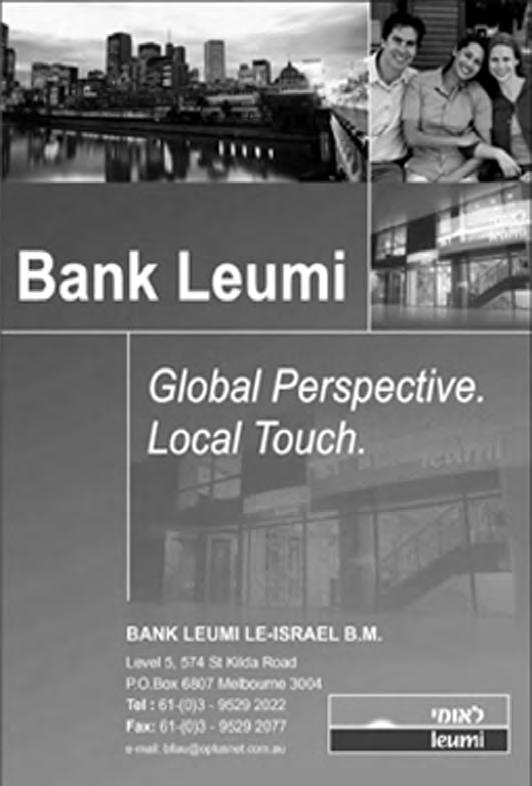


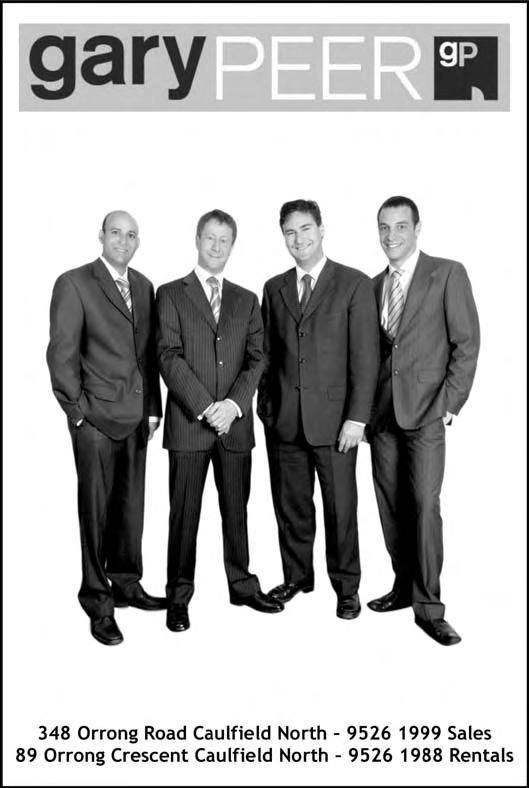
JHC Centre News 37

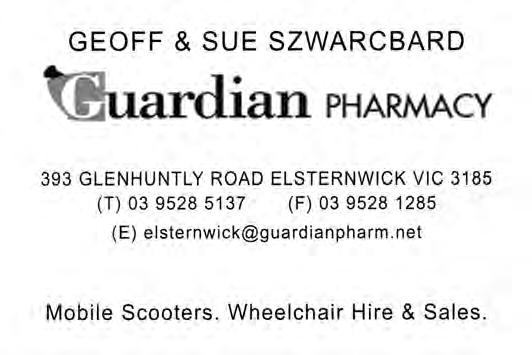



JHC Centre News 38



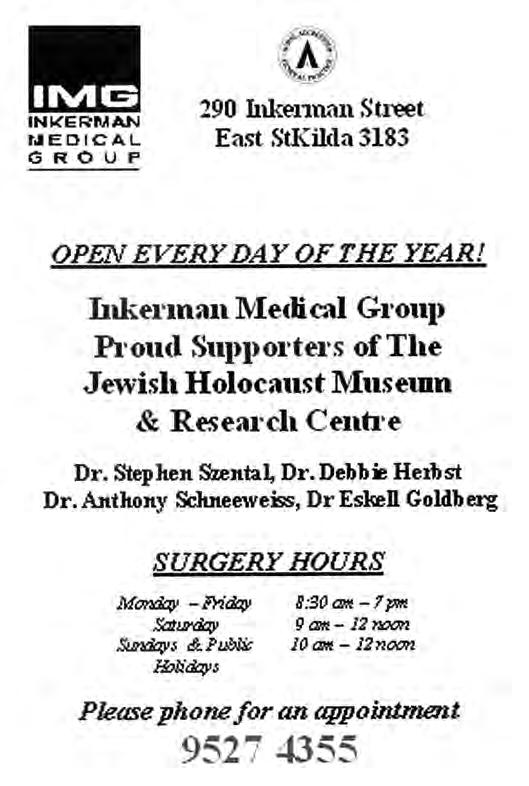
JHC Centre News 39





JHC Centre News 40 ADVERTISING If you would like to advertise in this section, contact Debra Stiebel or Robyn Fetter t: (03) 9528 1985 e: DebraS@jhc.org.au e: RobynF@jhc.org.au
JHC Centre News 41
JHC Centre News 42
JHC Centre News 43
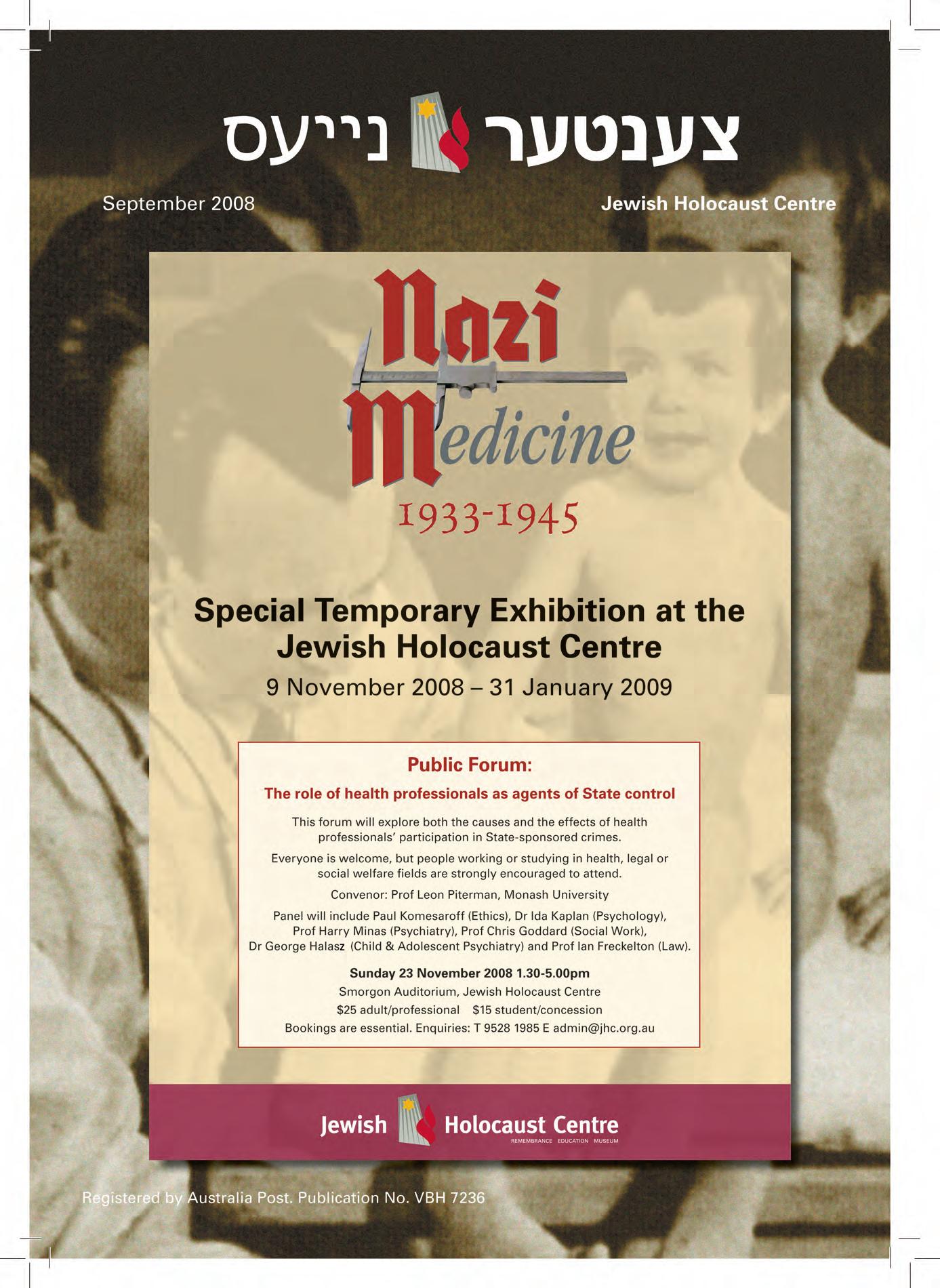



























 Zvi Civins
Zvi Civins

















 Zvi Civins
Zvi Civins



















































